CONNECTICUT INTEGRATED PEST MANAGEMENT PROGRAM
UConn IPM Program Team Delivers Educational Outreach
2023 IPM Program contacts:
| IPM Team Leader
Victoria Wallace |
860-885-2826 |
|
| Diagnostics
Nick Goltz |
860-486-6740 |
|
| Fruit IPM
Evan Lentz |
860-486-6449 |
|
| Greenhouse IPM
Leanne Pundt |
860-626-6855 |
|
| Rosa Raudales | 860-486-6043 | rosa.raudales@uconn.edu |
| Hemp Program
Shuresh Ghimire |
860-875-3331 |
|
| Invasive Species IPM Pesticide Safety Education Pollinator Program School IPM
Turf & Landscape IPM Victoria Wallace |
860-885-2826 |
|
| Vegetable IPM
Shuresh Ghimire |
860-875-3331 | shuresh.ghimire@uconn.edu |
| Ana Legrand | 860-486-0869 | ana.legrand@uconn.edu |
This report was edited by Victoria Wallace, IPM Team Leader.
For more information about the UConn IPM Program, please contact: Victoria Wallace, IPM Team Leader, University of Connecticut Department of Extension, 562 New London Tpke., Norwich, CT 06360 victoria.wallace@uconn.edu; 860-885-2826
IPM website: ipm.cahnr.uconn.edu
Introduction
The Integrated Pest Management (IPM) Program is a collaboration between UConn Extension and the Department of Plant Science & Landscape Architecture. Since its inception in 1980, the UConn IPM Program has made great strides in developing and implementing sustainable methods for pest control throughout Connecticut. Integrated Pest Management applies multiple tactics in a variety of settings through the selection of appropriate tools and the education of agricultural industry members and Connecticut citizens to provide sustainable, science-based approaches for the management of plant pests (insects, mites, diseases, wildlife, and weeds, including invasive plants). The UConn IPM Program incorporates all possible crop management and pest management strategies through knowledgeable decision-making, utilizing the most efficient landscape and on-farm resources, and integrating cultural and biological controls. Program objectives include maintaining the economic viability of agricultural and green industry businesses, enhancing and conserving environmental quality and natural resources, educating participants on the effective use of cultural practices to mitigate pest problems, of biological control agents, and educating pesticide users about bee and other pollinator safe materials, least toxic options, and the safe use and handling of organic and synthetic pesticide products. The 2023 IPM Program Team includes Shuresh Ghimire (Vegetables and Hemp), Nick Goltz (Diagnostician), Ana Legrand (Vegetable Entomology), Evan Lentz (Fruit), Leanne Pundt and Rosa Raudales (Greenhouse), and Victoria Wallace (School, Invasive, Pollinators, Pesticide Safety, Turf and Landscape).
The goal of IPM is to enable agricultural producers, green industry professionals, municipal/ school ground managers, and Connecticut citizens to reduce their dependence on pesticide use, while maintaining or improving productivity, crop value, and quality of life. The IPM Program educates stakeholders throughout the state regarding the judicious and safe use of all pesticides (organic and synthetic), as well as alternative pest control methods.
Broader adoption of IPM practices increases responsible pest management; may reduce management and production costs; minimizes adverse environmental and economic effects from pests and pest management; results in improved ecosystem quality and plant performance; and improves plant health, quality, yields, and aesthetics. The use of IPM includes cultural controls; biological control agents; biological fungicides; physical and mechanical controls; the use of resistant cultivars; regulatory controls; behavioral modification; and, chemical controls, with a focus on the selection of the least toxic product. IPM partners and collaborators include State and Federal agricultural and environmental/non-governmental agencies and organizations; CT and regional fruit, greenhouse, grounds manager, nursery, turfgrass, landscape, and vegetable associations; industry suppliers/dealers; regional universities; educators; schools and municipalities; individual growers, farmers, and producers; Master Gardeners; and the general public.
We were able to conduct many in-person and virtual programs. IPM Program team members conducted intensive on-site educational training for fruit and vegetable producers, greenhouse growers, nursery producers, garden center retailers, and turfgrass and landscape professionals. Growers and green industry professionals received information on the current status of and recommendations for important plant pests and training via pest messages, email alerts, webinars, newsletters, articles in national trade journals, management guides, websites, and social media, as well as consultations and counseling via phone and text, site visits to their business operations, workshops, field demonstrations and research projects, conferences, exhibits, and short courses. IPM programs are evaluated through pre- and/or post- program surveys and evaluations, needs assessment surveys, testimonials, and unsolicited comments.
IPM Outcomes
- The Fruit IPM program engaged 581 fruit growers and related industry members 30 times through ongoing e-updates, which include phenology, weather, pest management, cultural management, and meeting/event updates.
- A new Fruit IPM Internship Program was developed to assist in the ongoing statewide fruit pest scouting and trapping efforts, including monitoring of important invasive species: Brown Marmorated Stink Bug, Spotted Wing Drosophila, and Spotted Lantern
- Vegetable Integrated Pest Management education was delivered to over 600 vegetable growers and stakeholders every week from April to October 2023 through 21 weekly vegetable pest alert emails focusing on pests, pest management and decision making, and safe pesticide
- Fifty-three students enrolled in our online Vegetable Production Certificate course in the winter of 2023. The course had seven modules, each module with a self-paced video, supplemental materials, and a short quiz. In the post-course evaluation survey (N = 53, n = 40), respondents indicated their knowledge of the subjects increased from an average of 51% before the course to 80% after the
- Sixty-three attendees from CT and MA participated in an Ornamental Greenhouses conference. 100% of evaluation respondents stated that they learned skills that would help them with the diagnosis of plant
- 100% of evaluation respondents at the Trap Crops for Vegetable Insect Pest Management Workshop confirmed their knowledge of trap crop set up and arrangements
- 285 attendees participated in the Native Plants and Pollinators Conference, held in November 2023 at the University of Connecticut in Storrs, CT, which provided education about pollinator biology and conservation, as well as using native plants in the landscape to create aesthetically pleasing gardens that also support pollinators.
- The Ornamental and Turf Short Course provided the necessary information for participants to fulfill the requirements of the Ornamental and Turf/Golf Course Superintendents State of Connecticut Supervisory Pesticide Applicator Certification exam. The online winter session ran from January-March (73 attendees), and a fall session ran from October-early December (63 attendees).
- 110 turfgrass professionals, including municipal and grounds managers, attended a School and Municipal Turf/Grounds Workshop held on September 13, 2023 in South Windsor,
- At least 5,345 citizens directly and actively participated in invasive plant talks, symposiums, exhibits, and management activities in over 60 CT towns. Many (at least 4,670) were reached indirectly through articles, YouTube videos, social media, fact sheets, signs, and other educational mediums. A minimum of 30,765 hours were directly invested in invasive plant management, during intensive invasive plant training sessions and management activities, as well as educational outreach. A minimum of 5,300 hours were provided indirectly as citizens engaged in educational efforts and learned from videos, articles, and fact
- In 2023, there were 83,457 users of the IPM website (ipm.cahnr.uconn.edu). The total number of page views was 123,028.
IPM Program Funding
The Connecticut IPM Program is a collaboration between UConn Extension and the UConn Department of Plant Science & Landscape Architecture in the UConn College of Agriculture, Health & Natural Resources. The IPM Program Team acknowledges support from the following Federal, State, and private funding sources:
Connecticut Department of Agriculture
Connecticut Department of Energy and Environmental Protection (DEEP) Connecticut Farm Bureau
Multi-state Hatch Project NE-1032 National Plant Diagnostic Network (NPDN)
New England Vegetable & Berry Growers’ Association Northeastern IPM Center (NEIPMC) Northeast Organic Farming Association of Connecticut (NOFA)
Northeast Sustainable Agriculture Research and Education Program (SARE) Rose Mill Company, Hartford, Connecticut
The Connecticut Agricultural Experiment Station (CAES)
The University of Connecticut
The University of Connecticut Innovative Programming in Extension grant US Department of Agriculture (USDA)
Animal and Plant Health Inspection Service (APHIS)
USDA Agriculture and Food Research Initiative Education and Literacy Initiative (AFRI ELI) USDA Extension Risk Management Education Program (ERME)
USDA Federally Recognized Tribes Extension Program (FRTEP) USDA National Institute of Food and Agriculture (NIFA) Beginning Farmer and Rancher Development Program (BFRDP) USDA NRCS Conservation Innovation Grants (CIG)
USDA NIFA Crop Protection and Pest Management (CPPM) Extension Implementation Program (EIP)
USDA NIFA New Beginning for Tribal Students (NBTS) USDA NIFA Specialty Crop Research Initiative (SCRI) project USDA Northeast Region IR-4 Program
USDA Specialty Crop Block Grant (SCBG) Program National Plant Diagnostic Network (NPDN)
Vegetable IPM
Program Leader: Dr. Shuresh Ghimire, Assistant Extension Educator
2023 UConn Extension’s Vegetable and Small Fruit Growers’ Conference and Tradeshow
January 4, 2023, Sheraton South in Rocky Hill, CT
UConn Extension conducted the 2023 UConn Extension’s Vegetable and Small Fruit Growers’ Conference and Tradeshow on January 4, 2023 in Sheraton South in Rocky Hill, CT. This conference welcomed 194 participants and 27 trade show exhibitors. The topics covered included nutrient management in sweet corn; vegetable disease control with nanotechnology; plug vs bare root strawberries; small scale bean threshing project with UConn engineering students; trap crops; new opportunities to sell to K-12 schools and early care providers; winter growing in low tunnels; drone imaging to monitor potato leafhopper damage in the field; strawberries and irrigation/fertigation; ozone microbubble for produce safety; and no-till and soil health growers’ panel. Forty participants completed the program evaluation survey: 73% reported they definitely earned something new that will help with their business, while 20% reported they possibly learned something new and 7% did not respond to this question. Zero respondents reported that they did not learn anything useful for their business. Suggestions on the topics, speakers, and scheduling for the next conference was gathered through this survey to inform the next conference.
Comments from participants:
“This was a very good, informative meeting that us as a growers want to see continue. Thank you for hosting it.”
“Liked keeping vendors separate from talks.” “Wonderful job!”
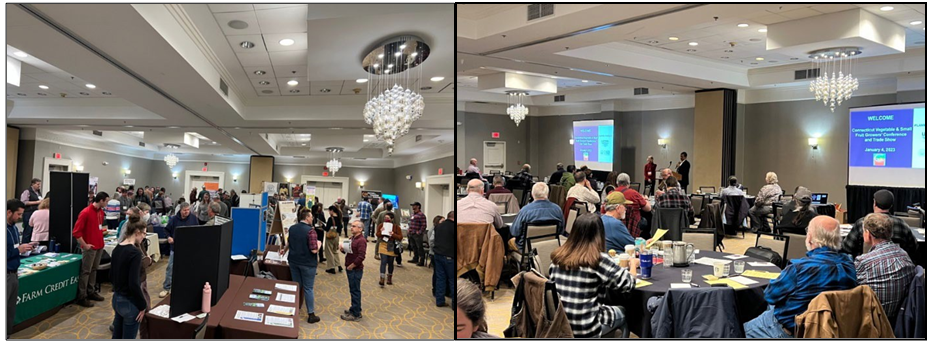
Low-to No-till Implement Demonstration Field Day
June 1, 2023, Cecarellis Harrison Hill Farm, Northford, CT
UConn Extension partnered with Connecticut Resource Conservation and Development (RC&D) to organize Low-to no-till implement field demonstration on June 1, 2023 collaborating with Cecarellis Harrison Hill Farm, Northford, CT. More than 80 farmers and stakeholders participated in the event. Farmer William Dellacamera led the live demonstrations of numerous low to no-till equipment including zone tiller, no-till drill, roller crimper, no- till corn planter, low till corn planter, speed disc tiller and plastic layer.
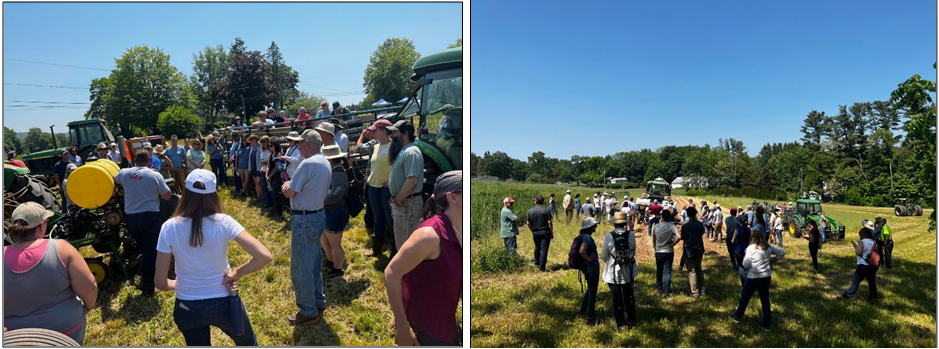
2023 UConn Extension Vegetable Production Certificate Course
Fifty-three students enrolled in the UConn Extension online Vegetable Production Certificate course in the winter of 2023. The course had seven online modules, each module with a self-paced video, supplemental materials, and a short quiz. This course was designed to benefit beginner vegetable producers with 0-3 years of vegetable growing experience or no formal training in agriculture. The participants learned answers to the basic questions about farm business planning, planning and preparing for vegetable farm, warm and cool-season vegetable production techniques, season extension, identification of biotic and abiotic issues, and marketing. In the post-course evaluation survey (total number of course participants = 53, number of respondents = 40), respondents indicated their knowledge on the subjects increased from average of 51% before the course to 80% after the course.
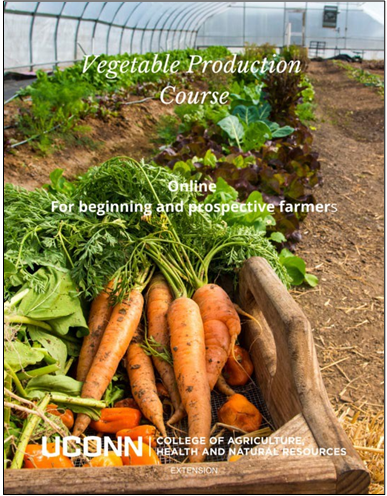
Comments from participants:
“The course went really smoothly, was easy to navigate, and the presentations covered a range of topics while also giving good details about the overview topics.”
“I loved everything about this!”
“Very good, I learned a lot about vegetable farms.”
“Appreciated hearing from the farmers in addition to the UConn staff/scientists.”
“Glad this course exists!”
“This was a great, informative course! Thank you for providing this to those who are interested. :)”
“Thank you so much for offering this course at such an affordable price and making it something I can work into my busy schedule- very well done!
Federally Recognized Tribes Extension Program (FRTEP) with Mashantucket Pequot Tribal Nation (MPTN)
UConn Extension received a FRTEP grant in 2017 for the first time. The main goals of the project were to improve food security in the MPTN, engage Tribal youth, boost the economic viability of the Tribe’s agricultural enterprises, and educate Tribal members about nutrition and health. Since the start of the UConn FRTEP, UConn Extension educators and staff have been working extensively with the MPTN and providing training to achieve the project goals.
The FRTEP project has achieved several measurable outcomes since its inception. The project goal to improve food security in the MPTN was accomplished through the establishment of meechooôk farm and cultivation of more land. Before the project started, only 1.5 acres of land was being cultivated on the reservation, but in 2022, cultivated acres had increased to 10 acres including the pasture. In 2022, approximately 40,000 heads of lettuce and 250 lbs of tomatoes grown in two hydroponic greenhouses were harvested. In the same year, summer squash, pumpkin, winter squash, cucumber, watermelon, basil, chard, and strawberry were cultivated and harvested from open fields spanning 1.5 acres. A container farming operation (40 ft x 8 ft x 9 ft) was initiated in December 2022; in the last six months 10,000 heads of lettuce has been harvested. Cows and pigs were added to the farm in spring 2022. Since then, 12 piglets were sold and three pigs were slaughtered. In 2022, the Meechooôk farm-grown produce and meat was distributed to180 tribal community members (15% of the MPTN population) every other week in food boxes supported by USDA’s Local Food Purchase Assistance Cooperative Agreement Program (LFPA). Additionally, 30 diabetic patients have been getting prescribed fresh produce from the farm since spring 2022 that is supported by Food Rx Program. In addition to sharing the farm products with the tribal members through the above-mentioned programs, farm products are being sold at the Foxwoods Resort and Casino and local supermarkets.
Additionally, the project has encouraged more households to start backyard gardening and established a school garden that program participants maintain. Jeremy Whipple, the Executive Director of the Tribal Department of Agriculture, has credited the FRTEP grant for this change, noting that before the project started, farming was seen as a hobby and not a potential source of income. Through the FRTEP grant, Meechooôk farm is equipped to scale up its production and sales, which will continue to improve food security and boost the economic viability of the Tribe’s agricultural enterprises.
During a focus-group discussion conducted with 12 Tribal leaders and members in 2022, there was a consensus that the health of the tribal members has improved since the start of the FRTEP through consumption of fresh nutritious food, an increase in number of tribal members practicing healthy eating habits, and exercise learned through the trainings provided by UConn Extension educators.
The UConn FRTEP project has had a significant impact on strengthening the relationship between UConn Extension and MPTN. The longstanding history of engagement between the two parties, with many Tribal members graduating from UConn and being part of the UConn Foundation Board, has been further enhanced through the extensive training and information provided by UConn Extension educators and staff to achieve the project goals identified by both parties. The FRTEP grant has built on the relationships and infrastructures that has enabled MPTN to secure additional funding from other agencies, including the Natural Resource Conservation Service and the Native American Agricultural Fund, to support their agricultural enterprise.
This successful partnership between UConn Extension and MPTN to improve the food security and sovereignty has been recognized by local and national news outlets including, The Day, Civil Eats, The Washington Times, US News, and The Hour. USDA NIFA has also highlighted the UConn’s FRTEP project through NIFA Update on September 21, 2022. The success of the project has led to the creation of the MPTN Department of Agriculture in 2021, which continues the education, nutrition, and farming work previously done in collaboration with UConn Extension. More information is available at s.uconn.edu/MPTN.
UConn Project team: Shuresh Ghimire (April 2019-present), Mary Concklin (2017-April 2019), Joseph Bonelli, Robert Ricard (2021-present), Miriah Kelly (2017-August 2020), Michael Puglisi, Pam Gray (2017-2021), Erica Benvenuti, Sara Tomis (2022 May-present), Jiff Martin (September 2022-present) and Indu Upadhyaya (September 2022-present). Funding: FRTEP Awards 2017-41580-26950 and 2022-41580-37944.
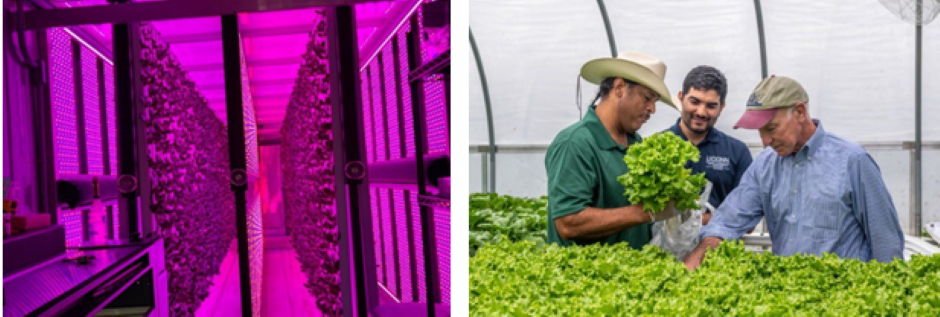
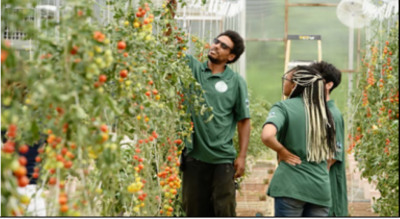
Weekly Pest Alert
Vegetable integrated pest management education was delivered to over 600 vegetable growers and stakeholders every week from April to October 2023 through 21 weekly vegetable pest alert emails focusing on pests, pest management and decision making, and safe pesticide use.
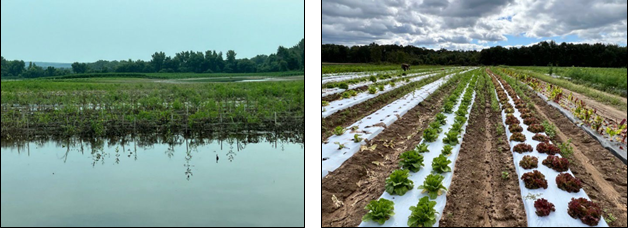
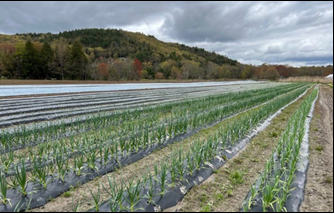
Fruit Production and IPM
Program Leader: Evan Lentz, Assistant Extension Educator
Operationalizing Drone Imaging Technology to Detect Nutrient Deficiencies in Fruit Orchards
This project is a continuation of our previous project “Drone Imagery for Early Detection of Fruit Crop Nutritional Deficiencies” funded through USDA SCBG via the CT Department of Agriculture. The first three-year project delivered 62 crop and nutrient specific predictive models. In this current three-year study, models are applied to support the need for foliar fertilizer applications in hopes of impacting the current year’s crop. This project includes seven grower participants: Belltown Hills Orchard, South Glastonbury; Blue Hills Orchard, Wallingford; Roger Orchard, Southington; Joseph Preli Farm and Winery, South Glastonbury; Scantic Valley Farm, Somers; Old Bishops Orchard, Cheshire; and the Mashantucket Pequot Tribal Nation, North Stonington. We have expanded participants to include new farmers, including women and BIPOC farmers. Data collection will continue for the next two years. Funding: Northeast SARE Research for Novel Approaches.
Solid Ground – New Farmer Training Sessions
Lentz served as one of the focus areas (Fruit Production and IPM) consultants for the Soil Ground New Farmer Training program. Lentz organized and led eight one-on-one on-farm consultations with new/beginning fruit farmers to assist in site evaluation, planning, varietal selection, and IPM program development. Funding: USDA NIFA CPPM.
One-on-one IPM Program Development
Lentz worked closely with three farms to develop and refine their IPM programs: Old Bishops Farm, Cheshire; Joseph Preli Farm and Winery, South Glastonbury; and March Farms, Bethlehem. The effort included regular trapping via the Fruit IPM Internship, NEWA Model integration, and pesticide application consultation. Funding: USDA NIFA CPPM.
Fruit IPM Messages
This is one of the most critical components of the UConn Fruit IPM program according to growers. These e- updates provide pertinent information during critical periods throughout the growing season. In these updates weather, phenology, management recommendations, local pest reporting (data gathered from across the state vis the internship program), IPM strategies, programming updates, and event information are provided to growers in a direct, distilled manner. Updates are uploaded to the IPM website. Funding: USDA NIFA CPPM.
Internship
Lentz developed an undergraduate Extension internship program focused on Commercial Fruit Production and Integrated Pest Management. One student was employed for 15 weeks, 40 hours per week. The student learned and employed IPM scouting and trapping techniques at a total of 14 fruit farms in the state, including both small and tree fruit. The student visited farms weekly, reported findings to growers, complied data to be shared with the fruit growing community, and worked to develop two educational factsheets on related insect pests. The student attended multiple educational and industry meetings. Funding: USDA NIFA CPPM, UConn Extension Summer Internship Grant (Internal).
Events
Two major educational meetings were planned and put on in collaboration with the Connecticut Pomological Society and UConn Extension Fruit IPM Program: Annual Summer Twilight Meeting and Field Day (125 attendees) and the Annual Winter Meeting (125 attendees).

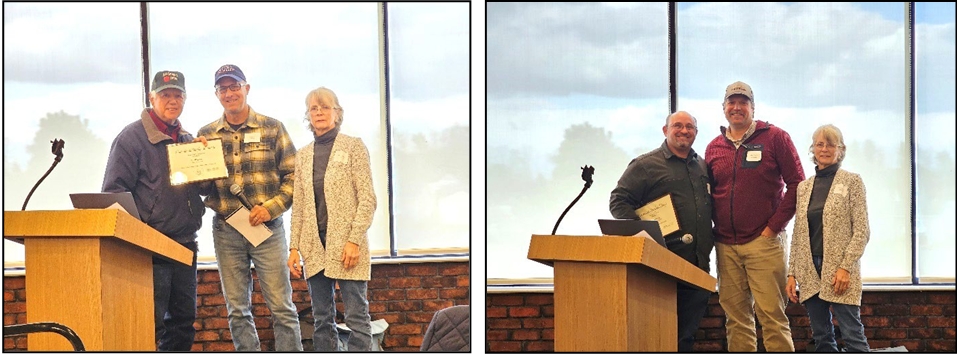
Other Programming
Lentz delivered a total of seven presentations this calendar year:
- Building Resiliency: Climate Smart Adaptations for Fruit Growers (UConn RMA Climate Smart Adaptation and Mitigation Workshop, 35 attendees)
- Fruit IPM: Scouting and Management in Connecticut Fruit Orchards (Plant Pest Control Guest Lecture, 4 attendees)
- Climate Instability and Pest Pressures in Connecticut Fruit Orchards (2023 Connecticut Agriculture Expo, 238 attendees)
- The Impact of Extension (The Common Shared Landscape of the U.S.A Guest Lecture, 80 attendees)
- Novel Blueberry Nutrient Management Tools (Massachusetts Cultivated Blueberry Growers’ Association Summer Meeting, 21 attendees)
- Drone Imaging and Nutrient Management (Connecticut Pomological Society Summer Twilight Meeting and Field Day, 125 attendees)
- Small Fruit IPM for the Home Garden (UConn PSLA HGEC IPM Seminar Series, 38 attendees)
Lentz updated the New England Small Fruit Management Guide (Chapter: Currants and Gooseberries), served as co-editor for the UConn IPM Crop Talk Newsletter and authored 4 articles for fruit producers: Fireblight Resistance Management, Understanding Spring Frosts, Rainfall and Root Rots, and Building Resiliency: Climate Smart Adaptations for Fruit Growers, and produced a Blueberry Weed Management Quick Reference Guide for attendees of the Blueberry Pruning Workshop. Lentz also pursued and received his Category 10 Research and Demonstration Pesticide Applicators License.
Greenhouse IPM
Program Leaders: Leanne Pundt (Extension Educator Emeritus) and Rosa Raudales (Associate Professor of Horticulture & Greenhouse Extension Specialist)
Greenhouses in Connecticut represent over one third of the state’s vibrant $4.7 billion agricultural economy and are integral to the success of all agricultural businesses, according to a 2021 study by Farm Credit East. The total economic impact of the 583 greenhouse businesses in the state was $390 million in 2020. With support from NIFA, researchers and educators from UConn Extension within the College of Agriculture, Health and Natural Resources (CAHNR) support greenhouse businesses in greenhouse production, water conservation, integrated pest management and innovative technology.
Consultations to Members of the Commercial Greenhouse Industry
124 one-on-one visits (95 by Leanne Pundt, 7 by Carla Caballero, 22 by the Raudales Lab team) to greenhouses and nurseries to provide technical recommendations on monitoring for insects and diseases, abiotic disorders, advice on the use of biological control agents and biological fungicides, and water and fertilizer use. If needed, plant or substrate samples were collected to help with diagnosis. Spanish-speaking workers were interviewed by Carla Caballero to gather information about specific needs on education in greenhouse production to develop educational materials in Spanish.
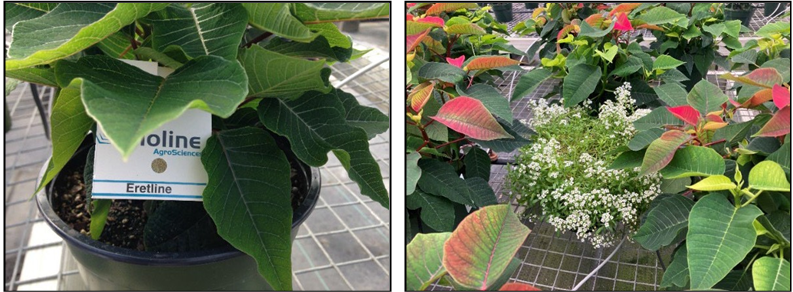
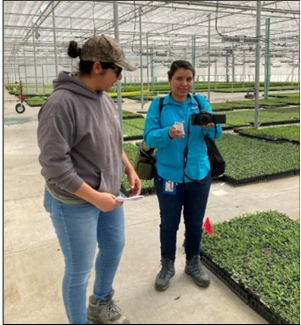
Diagnosis and Management of Plant Diseases in Ornamental Greenhouses Workshop
A full day conference was held on June 29, 2023, at the CT Agricultural Experiment Station in New Haven, CT. Topics presented included: Plant Disease vs. Nutritional Disorders, Collecting High Quality Samples, Blame it all on my ROOTS, Overview of Foliar Diseases, Help! My Leaves are Falling, and Diagnosis Hands-On. Sixty- three attendees from CT and MA participated in the conference. Of those that completed evaluation forms, 99% rated the conference as useful to very useful and 94% stated that they learned something that day that would help them adopt a new practice within the next year. 100% stated that they learned something that would help them tell the difference between biotic (living) and abiotic (nutritional disorders) and learned something that would help them with the diagnosis of plant diseases.
Comments from participants:
“Always worth the trip for the workshop.”
“Great talk about diagnosis; good conference; great lunch too.”
“Really informative conference and very affordable cost in a great venue, thank you; Emma’s presentations were informative on a complicated topic”
“Conference was awesome, I learned so much, thank you.”
“I really enjoyed the hands-on diagnosis session. Seeing the same disease on different species is so helpful.”

Bedding Plants – Spring 2023
A half-day meeting to update and prepare growers on emerging pests and diseases for the 2023 season was held at the Litchfield County Extension Center on January 18, 2023. Twenty-four growers attended. Of those that filled out evaluation forms, 100% rated the meeting as useful to very useful and were moderately to very likely to adopt a new practice.
Northeast Greenhouse Conference – Fall 2023
The Northeast Greenhouse Conference & Expo is a biennial, two-day conference coordinated by the New England Floriculture, Inc. Growers’ Association. The conference includes 37 educational sessions and network opportunities for greenhouse growers in the region. Greenhouse growers (> 500) from across the northeast attended this year’s conference (Manchester, NH on November 8 and 9, 2023).
Greenhouse Pest Messages
Weekly or biweekly pest messages were written by L. Pundt and posted on the UConn Greenhouse IPM website ipm.cahnr.uconn.edu/greenhouse and emailed to 290 members of the CT Greenhouse industry. Thirty-two messages were sent in English (email open rate of 70%). Sent 32 in English; 18 in Spanish.

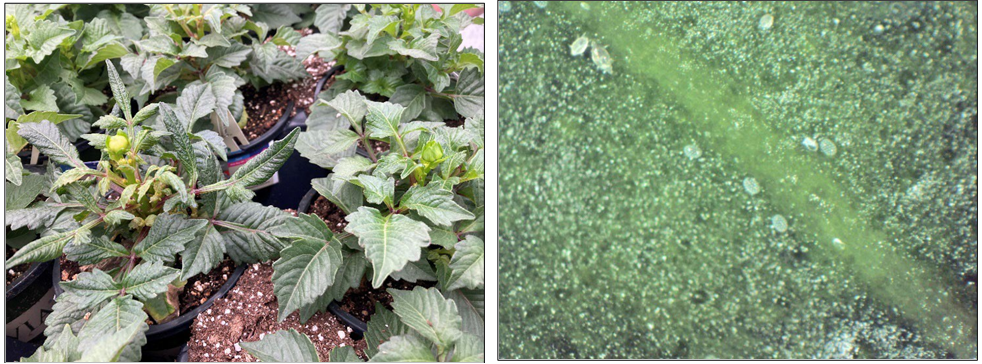
Created Training Videos in Spanish and English and uploaded to the UConn Greenhouse Channel
Produced 10 training videos in Spanish and English and uploaded to The UConn Greenhouse Channel on YouTube (874 subscribers). https://www.youtube.com/channel/UCJbcMQSF8bqpuzNjGUPweTw
Inspect the proper function of fertilizer injectors. R. Raudales, C. Caballero, L. Pundt and D. Pantoja. July 27, 2023. English version (views 166) https://www.youtube.com/watch?v=wHdH8aqvjOU and Spanish version (views 45) https://www.youtube.com/watch?v=InS0pUNKR5o
Identifying broad mites and their damage. R. Raudales, L. Pundt, C. Caballero. May 7, 2023. English version (views 1.5k): https://youtu.be/NFAOpecX0oc Spanish version (views 731): https://youtu.be/ycmtdX1UVT0
Sanitation practices during the growing season. R. Raudales, L. Pundt, C. Caballero, M. Toro. January 31, 2023. English version (views 135): https://youtu.be/OXzSxeExnr0 Spanish version (views 68): https://youtu.be/5CT_Rkia7SA
Sanitation of hard surfaces between crops in greenhouses producing ornamental plants. R. Raudales, L. Pundt, C. Caballero, M. Toro. January 31, 2023. English version (views 133): https://youtu.be/n-016p1F6q4 Spanish version (views 66): https://youtu.be/adOaOWXKGfM
Weed control as part of sanitation practices in greenhouses producing ornamental plants. R. Raudales, L. Pundt, C. Caballero, M. Toro. January 31, 2023. English version (views 135): https://youtu.be/eeAIB- KBPFw Spanish version (views 92): https://youtu.be/DLolPfLoazM
Views noted were tabulated as of 12/7/2023.
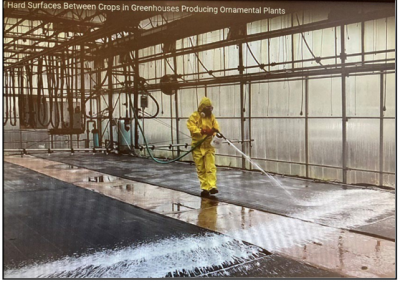
Webinars for Spanish Speaking/Workers in the Green Industry
We targeted this audience because the green industry is the largest segment of Connecticut’s agriculture equating to 51% of total production in gross sales. Nationally, 70% of the green industry’s workforce self-identifies as Hispanics. In our survey, operations indicated having between 41 and 100 staff members that speak Spanish as their primary language.
Presentations in Spanish to Greenhouse Industry
- Caballero, C & R. Raudales. 2023. “Enfermedad o desorden abiótico?” Online training. 27 March. (17 attendees).
- Caballero, C & R. Raudales. 2023. “Pasos de como iniciar un programa de control biológico para plagas de insectos y ácaros.” Online training. 24 March. (17 attendees)
- Caballero, C & R. Raudales. 2023. “Monitoreo de tarjetas adhesivas amarillas en invernaderos.” Online training. 23 March. (37 attendees).
- Caballero, C & R. Raudales. 2023. “Control de malezas como parte de las prácticas de saneamiento en invernaderos que producen plantas ornamentales.” Online training. 21 March. (27 attendees)
- Toro, M. & R. Raudales. 2023. “Alimentando plantas.” Online training. 29 March. (19 attendees).
- Raudales RE. 2023. “Como regar cultivos de contenedor.” Online training. 28 March. (17 attendees)
- Raudales, R. Surface sanitation (March 20, 2023): The participants that completed the training session poll indicated to have an intermediate and advanced level of knowledge on surface sanitation in the greenhouse (36% and 43% respectively), 94% responded that they understand the concept and importance of sanitation in the greenhouse after the session. (25 attendees)
- Caballero, C & R. Raudales. Weed control (March 21, 2023): The participants that completed the training session poll indicated to have an intermediate and advanced level of knowledge on weed control in the greenhouse (20% and 60% respectively), 87% responded that they understand the concept, methods of control, and importance of weed control in the greenhouse after the session. (27 attendees).
- Toro, M & R. Raudales. Sanitation practices (March 22, 2023): The participants that completed the training session poll indicated to have a basic and intermediate level of knowledge on sanitation practices in the greenhouse (40% and 40% respectively), 100% responded that they understand the concept, methods of control, and importance of sanitation practices in the greenhouse after the session. (21 attendees)
- Caballero, C. & R. Raudales. Reading sticky cards (March 23, 2023): The participants that completed the training session poll indicated to have a basic and intermediate level of knowledge on the correct use of yellow sticky cards in the greenhouse. (30% and 30% respectively), 100% responded that they understand the correct use of yellow sticky cards and feel more prepared to identify insects trapped on the cards after the session. (37 attendees)
- Caballero, C. & R. Raudales. Steps to start a biocontrol program (March 24, 2023): The participants that completed the training session poll indicated to have a basic and intermediate level of knowledge on biological control in the greenhouse. (20% and 50% respectively), 60% responded that they understand the concept of biological control and feel more prepared to start a biological control program in the greenhouse after the session. (16 attendees)
- Caballero, C. & R. Raudales. Disease or abiotic disorders. Plant disease or disorder? (March 27, 2023): The participants that completed the training session poll indicated to have a basic and intermediate level of knowledge on diagnose plant diseases (33% and 50% respectively), 100% responded feeling more prepare to diagnose plant diseases and disorders after the session. (15 attendees)
- Raudales, R. Irrigation of container-grown crops (March 28, 2023): The participants that completed the training session poll indicated to have a basic and intermediate level of knowledge on container irrigation. (30% and 40% respectively), 100% responded feeling more prepared to irrigate containers after the session. (17 attendees)
- Toro, M. & R. Raudales. Feeding container-grown crops (March 29, 2023): The participants that completed the training session poll indicated to have an intermediate and advanced level of knowledge on plant nutrition (57% and 29% respectively), 80% responded to understand the principal functions for nutrient in plants. (19 attendees)
Comments from participants:
- “Me gusta el formato corto y conciso. De esta manera hay oportunidad de estudiar sin perder medio día de trabajo”
Translation: I like the short and concise format. In this way, there is an opportunity to study without losing half a day of work.
- “Felicito al equipo (Rosa, Carla y Mayra) que organizo el programa de entrenamiento, sus presentaciones fueron bien clara, explicativas y concisas; además compartieron información complementaria que contribuyen para el aprendizaje del participante. Yo recomendaría y motivaría este entrenamiento en la industria… esta excelente!”
Translation: I congratulate the team (Rosa, Carla, and Mayra) who organized the training program, their presentations were very clear, explanatory, and concise. They also shared complementary information that contributes to the participant’s learning. I would recommend and encourage this training in the industry…it is excellent!!!”
Pollinator Program
Program Leader: Victoria Wallace, Extension Educator
Supporting pollinator health is a high priority for the UConn Extension Sustainable Landscapes program. Declining pollinator populations are a great concern in all habitats, including those in managed landscapes. Green industry professionals can support pollinator health by incorporating more native plants in managed landscapes. Meadows are one viable option for expanding the use of native plants in managed landscapes.
Many municipalities and school grounds managers have expressed interest in developing meadow areas that can be used to provide biodiverse habitats for pollinators. A meadow on a school/municipal property is an opportunity to reduce inputs, particularly mowing. Many in the municipal sector have limited budgets, manpower, and tools; they cannot use EPA registered pesticides to aid in meadow establishment. It is critical that managers understand the challenges with establishing and maintaining a meadow.
A small meadow area was established at the UConn Plant Science Research Facility in 2022 to serve as a demonstration and educational resource that will help address questions related to meadow establishment and maintenance. In 2023, we maintained the meadow plots and compiled data related to the plant growth, including recording stem counts of each species present in both the spring-seeded and the fall-seeded plots to compare rates of establishment. We continue to evaluate meadow establishment practices, planting methods, and weed management strategies.
We shared native plant information and fact sheets with over 2000 constituents through our Native Plant email listserv, as well as reached over 1300 through our Invasive Plant email listserv and over 700 through our school IPM email listserv. Many others also receive the information via UConn Extension and other partners who share our information. We also translated several pollinator health factsheets into Spanish.
Pollinator health was included as part of ornamental & turf pesticide online education program held this winter (73 enrolled) and fall 2023 (63 enrolled), as well as the School IPM Workshop in August 2023.
Native Plants and Pollinators Conference
November 2, 2023, Storrs, CT
Organizers: Victoria Wallace, Extension Educator, and Jessica Lubell-Brand, Associate Professor
The fourth biennial Native Plants and Pollinators Conference was held on November 2, 2023 at the University of Connecticut in Storrs, CT. The conference provides education about native plants in the landscape and creating aesthetically pleasing gardens that support pollinator health. In addition, the conference provides education about pollinator biology and conservation. An important component of the educational programming is the inclusion of research-based information in presentations. Conference attendees include nursery growers, garden center managers, landscape professionals, extension educators, land and municipality managers, master gardeners, and garden writers, consumers, and enthusiasts.
Presentation topics for the 2023 conference included fast-growing plants (annuals and herbaceous perennials) for instant pollinator habitat, how to collect and sow native plant seeds, monarch butterfly biology, ecology and conservation needs, new native shrub and tree cultivars for pollinators, and an introduction to honeybee colonies, beekeeping, and garden design to support bees. 285 people attended the day-long, in person conference.
Based on conference evaluations (n=180), attendee knowledge of presentation topics increased from an average of 2.8 (on a scale of 1 to 5, with 1 being no knowledge and 5 being great knowledge) before the conference to an average of 4.3 after the conference. Attendees learned the most about monarch conservation, native shrub and tree cultivars and how to handle native seeds. Based on the evaluation survey, 90% of respondents indicated that they are likely to use what they learned from the conference in their landscape and garden management and conservation. 93% of respondents indicated that they were more knowledgeable about native plants and pollinators after attending the program and that the content of the sessions was relevant to their work. 96% agreed that the conference provided practical, useable ideas and that the symposium was well organized.

Comments from participants:
“Speakers were well-informed and entertaining. PowerPoints were engaging. Overall well-done!”
“All presenters offered new information that I will use in my personal and community gardening. Thanks!” “Wow! What a great day with awesome speakers! Thank you!”
“The speakers excelled at all of the presentations. Wonderful to have such enthusiastic speakers.”
“I feel like I learned something from each presenter that will help me answer questions from landowners and municipalities. The instant pollinators and native cultivars especially will help me give specific answers for homeowners to implement.”
Invasive Species IPM Program
Program Leader: Victoria Wallace, Extension Educator
Invasive Plants: A Growing Concern
IPM methods can be used to manage invasive plants in residential properties, communities, and natural and managed landscapes. The Connecticut Invasive Plant Working Group (CIPWG) is a consortium of members of environmental organizations and affiliates of municipal and state agencies whose mission is to promote awareness of invasive plants and their non-invasive alternatives. CIPWG’s news and events listserv has 1250 members. The CIPWG website (cipwg.uconn.edu) provides information on invasive plant identification and management, the Connecticut list of invasive plants, photos, native plant and other non-invasive alternatives, and legislative updates. Planning for the 2024 biennial CIPWG symposium has begun. Ms. Wallace serves as a co-chair, UConn Liaison, and member of the steering committee and Symposium Planning Committee for CIPWG.
CIPWG exhibits were displayed, invasive plant talks were presented, invasive plant educational materials were provided, and/or invasive plant management activities occurred in over 60 CT towns. At least 5,345 citizens directly and actively participated in the activities. Many (at least 4,670) were reached indirectly through articles, YouTube videos, social media, fact sheets, signs, and other educational mediums. A minimum of 30,765 hours were directly invested in invasive plant management, during intensive invasive plant training sessions and management activities, as well as educational outreach. A minimum of 5,300 hours were provided indirectly as citizens engaged in educational efforts and learned from videos, articles, and fact sheets.
Victoria Wallace also served as the UConn CAHNR Dean Representative and Chair of the Invasive Plants Council (IPC), a state-legislated committee mandated by the CT Environment Committee, for the 2023 term.
Invasive Biological Control Projects: Swallowwort
Victoria Wallace serves as the Principal Investigator for a USDA APHIS biological control project of swallow- wort, a serious invasive weed of meadows, pastures, roadsides, woodland edges and coastal shorelines. Ms. Wallace supervises the efforts of the research technician who evaluates seasonal feeding damage of the biological control agent (Hypena opulenta) after its release onto dense monocultures of swallowwort. In 2023, the fourth year of the project in CT, former release sites were re-evaluated for feeding damage to confirm successful overwintering of the biocontrol agent. A fact sheet and an infographic for swallow-wort biological control are available on the IPM website. The introduction and establishment of biological control agents to reduce populations of swallowwort in CT provide a sustainable method of managing this invasive pest in open spaces throughout Connecticut.
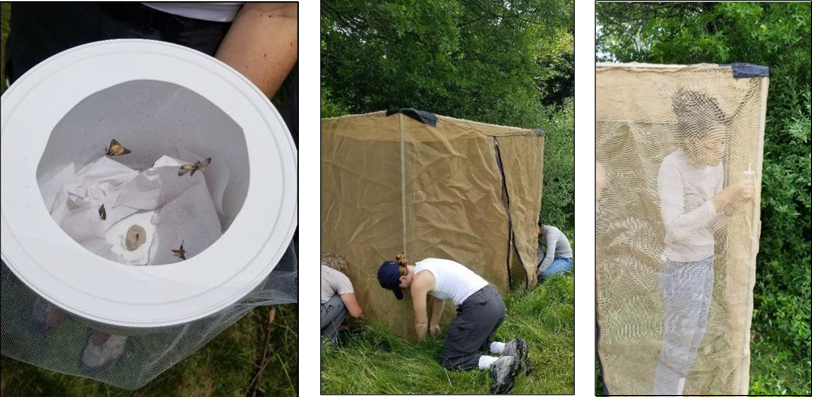
School IPM Program
Program Leader: Victoria Wallace, Extension Educator
The Connecticut School IPM Coalition was formed to support School and Municipal Grounds Managers with turf care and landscape practices following the statewide ban of pesticides on daycare and K-8 school properties. Coalition members develop and present in-person educational workshops for school grounds and athletic field managers and their staff. Assessment tools and recommendations for school grounds and athletic fields that support management practices have been developed.
A School and Municipal Turf/Grounds Workshop was held on September 13, 2023 in South Windsor, CT. Attendees included municipal and grounds managers. The program was attended by 110 turfgrass professionals.
Session topics included:
- Using Alternative Management Strategies for Safe Playing Fields, Zachary Holm, CSFM, Turf Care Manager, Central Park Conservancy, NYC
- Fertilizer, Cultivation, and Overseeding Considerations for Fall and Early Spring, Jason Henderson, Associate Professor of Soil Science, University of Connecticut
- Invasive Plant ID & Management Tactics, Dave Laiuppa, Environmental Planner, Manchester, CT and Todd Mervosh, TM Agricultural and Ecological Services, LLC
- A Pesticide Management Summary – Updates and Current Topics of Interest, Diane Jorsey, Supervising Environmental Analyst, CT DEEP, Pesticide Management Division
- Tree Health and Pest Issues, Gregory Foran, Parks Superintendent and Tree Warden, Town of Glastonbury, CT
- Tools for School Grounds Managers: Communication with Town Administrators and Stakeholders, Vickie Wallace, Extension Educator, UConn Extension
- Panel: Ask the Experts, Jason Henderson, Diane Jorsey, Zachary Holm, Greg Foran, Dave Laiuppa, Todd Mervosh, Vickie Wallace, John Caldwell and Dave Turkington
95% of attendees agreed that the workshop provided practical ideas for turf and landscape management. 96% of attendees said that they are more knowledgeable about grounds management options because of the program. 100% of evaluation respondents rated the programs as good or excellent. Attendees’ knowledge about CT School IPM increased from 2.9 before the conference to 4.40 after (on a scale of 1-5).
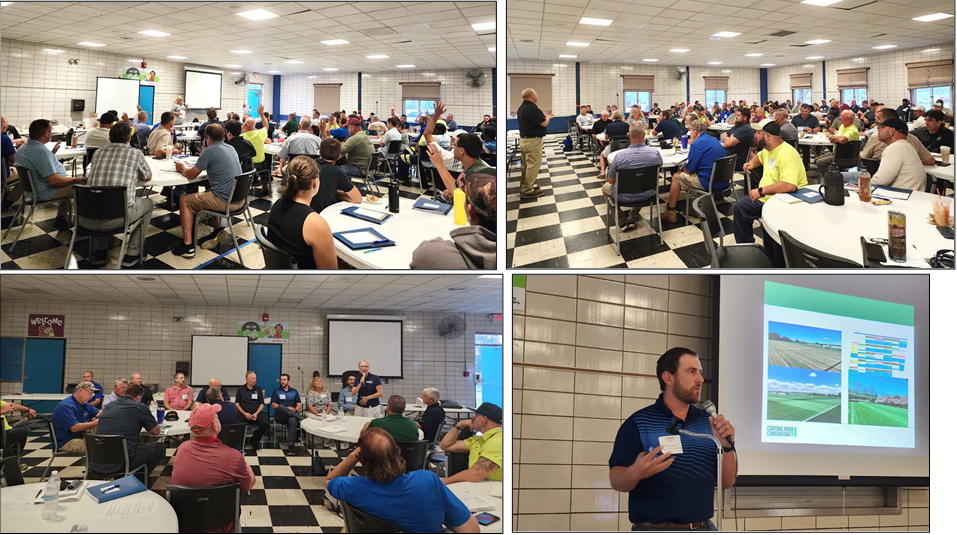
Comments from participants:
“Great workshop! Thank you for doing what you do.” “Keep up the good work.”
“Wonder presentation! The Ask the Experts panel was a great idea.”
“Very good presenters; subjects were interesting. Great job!”
Victoria Wallace and Alyssa Siegel-Miles, Research Assistant, continued to produce Extension documents that benefit school ground managers and added them to the IPM website, including:
- Wallace, V. and A. Siegel-Miles. 2023. Best Management Practices for Pesticide-Free Landscape Maintenance on CT School Grounds. 54 pp. Best Management Practices for Pesticide-Free CT School Landscapes
- Picone, V. Wallace, A. Siegel-Miles, and S. Tomis. 2023. Native Tree and Shrub Availability List. 12 pp. ipm.cahnr.uconn.edu
- Wallace, V., A. Siegel-Miles, and S. Tomis. 2023. Connecticut Native Meadow Seedling and Plant Identification Guide. 19 pp. ipm.cahnr.uconn.edu
Additionally:
Victoria Wallace served as the chair of the task force that developed “Best Management Practices for the Sports Field Manager: A Professional Guide for Environmental Sports Field New England Sports Turf Managers Association” (nestma.org).
The design and building blocks of construction of the athletic field assessment tool app have been completed. The app is being field tested to improve the user experience and identify any needed corrections before finalization.
Two Research Technicians for School IPM program attended University of Rhode Island’s invasive plant training, in order support the UConn invasive plant program.
School and municipal grounds managers, nursery managers, and landscape professionals from 169 CT towns received 13 emails with information, educational materials, and best management practices.
Weather stations previously placed at Connecticut schools and used to assist with critical IPM decision- making on athletic fields and school grounds management has continued. Wallace served as the CT state coordinator for the NEWA system and encouraged continued use of NEWA system weather stations at schools.
Victoria Wallace provided one-on-one consultation and support of Landscape Professionals. 55 one-on- one consultations were completed via phone, text, and email. Wallace provided Sustainable Landscape expertise, including pollinator health via periodic email and phone consolations.
Sustainable Landscapes Program
Program Leader: Victoria Wallace, Extension Educator
Ongoing evaluation of turfgrass cultivars under low maintenance regimes was conducted. UConn is a cooperator evaluation site for the National Turfgrass Evaluation Program (NTEP) and the Alliance for Low Input Sustainable Turfgrass (A-LIST). Selection of sustainable turfgrass varieties is important for all turfgrass professionals, including turfgrass managers who must manage non-irrigated, pesticide free school athletic fields with a limited budget and few resources. Use of turfgrass seed mixtures that include improved cultivars that perform well with fewer inputs is an important management strategy for school and municipal grounds managers.
National Turfgrass Evaluation Program
Tall Fescue Test
Year 5 data was collected for a 5-year evaluation test of turf-type tall fescue cultivars. UConn serves as an evaluation location for this national turfgrass test.
Fineleaf Fescue Test
Year 3 data was collected for a 5-year evaluation test of fine fescue cultivars. UConn serves as an evaluation location for this national turfgrass test.
Perennial Ryegrass
Year 1 data was collected for a 5-year evaluation test of perennial ryegrass cultivars. UConn serves as an evaluation location for this national turfgrass test.
Alliance for Low Input Sustainable Turfgrass (ALIST) Evaluation
The A-LIST Fine Fescue Test was seeded in September 2021. Data was collected for 2023 (Year 2) of the fine fescue evaluation trial. UConn serves as a cooperator site for this low input evaluation test.
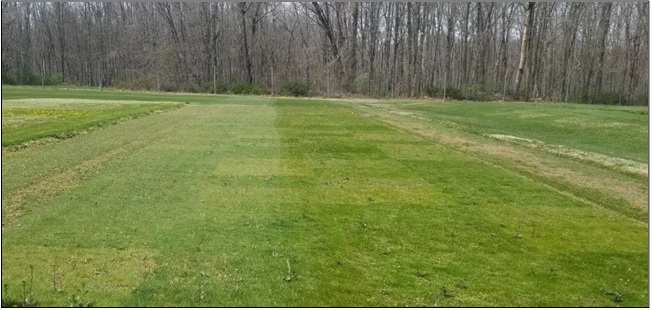
Conference Programs
Presentations were conducted virtually and in person (nationally, regionally and in state). Victoria Wallace was a presenter at the New England Regional Turfgrass Foundation (NERTF) conference, Connecticut Environmental Council (CTEC), Vermont Greenscape Conference, and for the New England Sports Turf Managers Association webinar series. Presentation topics included integrating environmentally sound best practices in athletic field maintenance programs, turfgrass selection and establishment considerations impacted by weather, and turfgrass management strategies related to pollinator health.
Cornell “Short Cutts”
1. Wallace serves as UConn representative for a regional turfgrass conference call and newsletter (33-35 weeks/year; April-October), hosted by Cornell Extension faculty. IPM recommendations for turfgrass managers along with current research and weather forecasting were made available to Extension faculty in the Northeast.
Pesticide Safety Education
Program Leader: Victoria Wallace, Extension Educator
Ornamental and Turf Short Course
This Short Course provides an in-depth online educational program that reviews the information necessary to fulfill the requirements of the Ornamental and Turf/Golf Course Superintendents State of Connecticut Supervisory Pesticide Applicator Certification exam. There are eight modules for this educational program. Class topics are: Pesticide Laws, Regulations and Safety; Botany; IPM Principles; Plant Pathology and Ornamental Plant Diseases; Entomology and Insect Pests of Woody Ornamentals; Area and Dosage Calculations; Turfgrass Management; and Weed Management. Each class begins with a brief overview of the topic, then continues with an in-depth discussion of pests, their biology and control. In 2023, the online winter session ran from January-March (73 attendees), and a fall session ran from October-early December (63 attendees). Instructors included: Victoria Wallace, Nick Goltz, Srikanth Kodati, Sarah Bailey, and Robert Durgy (CT Agricultural Experiment Station).
Diagnostics
Program leader: Dr. Nick Goltz, DPM, Assistant Extension Educator
Between January 1 and December 8, 2023, the UConn Plant Diagnostic Laboratory (PDL) processed a total of 265 physical samples. This slight decrease may be partly attributed to a surge of Tomato spotted wilt virus (TSWV) last year, as well as the relocation of the PDL to a new, temporary, location (W.B. Young 011) in January and February of this year.
Additionally, the lab directly responded to at least 320 stakeholder plant health inquires via phone, email, and walk-in. The lab also directly supported the efforts of the UConn Home & Garden Education Center (HGEC), which responded to more than 1,909 additional stakeholder inquiries in 2023. Sample types submitted this year included agronomic field crops, landscape ornamentals, ornamentals from nurseries and greenhouses, plants grown for the purpose of conducting research, and specialty fruit, ornamental, and vegetable crops. Samples were accepted from both homeowner and commercial clients from all eight Connecticut counties, as well from several counties in Massachusetts and New York. Diagnostic services rendered included plant disease diagnoses, abiotic disorder diagnoses, plant identification, and insect identification. More than 1,430 diagnostic procedures were performed to arrive at the provided diagnoses. A cost-recovery sample processing fee of $20.00 per sample was covered by this USDA NIFA CPPM grant for samples from Connecticut commercial growers. The submission fee for 141 samples (of 100 budgeted) was covered in this way.
In 2023, Dr. Goltz wrote five blog posts and four articles for newspapers or online news sites that covered plant health and IPM topics. He was interviewed by a columnist for the Associated Press for the article, “Where Flooding Has Become More Frequent, Here’s How Gardeners Can Respond.” The story was picked up and published by several outlets. He hopes to have a fact sheet on flooding and two fact sheets on diseases published by UConn Extension by the end of the year. Goltz presented three modules for the pesticide applicator certification course, five plant pathology classes for the UConn Master Gardener program, and presented as a guest lecturer five times for courses taught at UConn.
Goltz gave presentations for the 2023 Connecticut Flower and Garden Show and the 2023 UConn Vegetable IPM Field Workshop. He was an invited speaker for the May 2023 meeting of the Connecticut Horticultural Society and gave a presentation titled, “Healthy Plants, Indoors and Out.” Goltz also organized the Second Annual IPM Seminar Series and presented a talk titled, “2023 Disease Update & Plant Health Tips.” The UConn Plant Diagnostic Lab is part of the National Plant Diagnostic Network, an internationally recognized consortium of plant diagnostic laboratories funded in part by the USDA National Institute of Food and Agriculture and the US Department of Homeland Security.
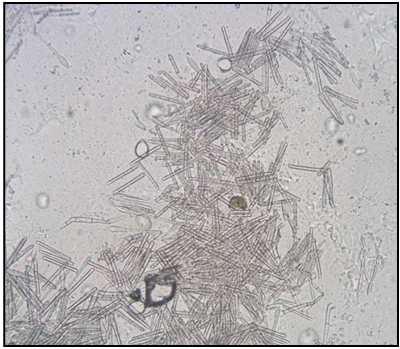
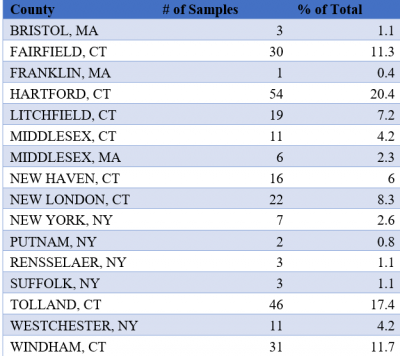
Vegetable Entomology
Program Leader: Dr. Ana Legrand, Assistant Extension Professor
Potato Leafhopper Monitoring & Remote Sensing Project
A multi-disciplinary team at the University of Connecticut continued work to develop a monitoring system for insect pest damage using drones outfitted with spectral sensors. The goal is to detect the presence and early plant damage caused by the potato leafhopper (PLH) on green beans. PLH is a significant pest in several horticultural systems; this work has the potential to benefit multiple commodities through early detection of the insect with minimal labor inputs by growers. PhD student Bivek Bhusal worked on greenhouse and field experiments to advance this project.
In 2023, the project expanded to evaluate abiotic factors like nitrogen fertilization that could confound remote sensing signals from PLH feeding damage. Results indicate that it is possible to detect PLH infestations using drones to capture spectral images from the field. Mr. Bhusal has shared project results by presenting at the Entomological Society of America Annual Meeting, the UConn Vegetable IPM Field Workshop, and the ‘Connecticut GIS Day 2023’ conference organized by the Connecticut GIS Network at Waterbury Campus, University of Connecticut.
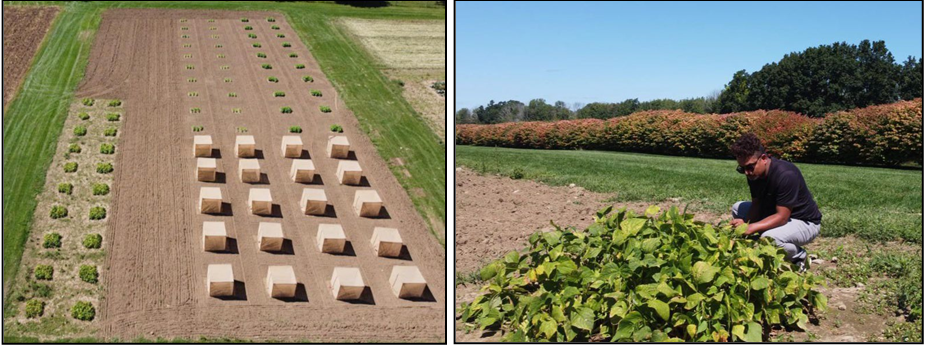
Brassica Trap Crops Project
Efforts to develop a ‘push-pull system’ for diamondback moth management in cabbage continued and confirmed that the system works even when trap crop density is reduced. Trap crops attract the pest away from the main crop, thus concentrating pest infestations in a smaller area that could be treated or destroyed. Project results indicated the strong potential of glossy collards and red Russian kale as trap crops when planted together with tomatoes as the repellent crop to create the ‘push-pull’ system. Repellent plants act as the ‘push’ factor and complement the trap crops providing the ‘pull’ effect to reduce pest pressure on the cash crop. Maussi Arrunategui, PhD student in Dr. Legrand’s lab, worked on the project and has presented results at the New England Vegetable and Fruit Conference, the Entomological Society of America Annual Meeting, and the UConn Vegetable IPM Field Workshop, among others.

Vegetable Entomology Outreach
Dr. Legrand gave several presentations on vegetable insect pest management and co-organized the 2023 Vegetable IPM Field Workshop with Dr. Shuresh Ghimire. The workshop was conducted at the Plant Science Research and Teaching Facility in Storrs. The field workshop covered diverse topics of importance to vegetable growers, including weed management, plant diseases, and insect pests. On insect pest management topics, attendees rated their before- and after-program knowledge change as follows (1-5 rating scale with 5 being most knowledge): 1.5 to 3.4 regarding allium crop pests, 2.1 changing to 3.5 for push-pull system for diamondback moth management, and 2.1 increasing to 3.4 on remote sensing of potato leafhopper damage. Dr. Legrand also participated in the planning committee for the 2023 UConn Extension CT Vegetable and Fruit Growers Conference.
Comment from 2023 Vegetable IPM Field Workshop participant:
“I learned great new methods for pest/disease monitoring and control. Thank you!”
Over the summer, Emma Fox, undergraduate student in the Department of Plant Science and Landscape Architecture and UConn Extension Summer Intern, participated in lab outreach activities. She learned about applied research from graduate students in the lab, conducted a ground beetle field survey to develop outreach materials about these beneficial insect predators and interviewed vegetable growers about their beneficial insect conservation practices.
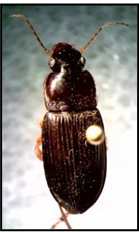
2023 IPM Projects and Publications
Arrunategui, M. 2023. Evaluation of a push-pull system for diamondback moth management. Field research update, Vegetable IPM Field Workshop. Plant Science and Landscape Architecture Research and Teaching Facility. August 9, 2023.
Bhusal, B. 2023. Remote sensing of potato leafhopper damage. Field research update, Vegetable IPM Field Workshop. Plant Science and Landscape Architecture Research and Teaching Facility. August 9, 2023.
Goltz, N.C., NEERA Annual Meeting – CT IPM Report. Submitted March 31, 2023.
Goltz, N.C., 2023. “Dandelions: from Famine Food to Fabulous Forage.” University of Connecticut Ladybug Blog. https://uconnladybug.wordpress.com/
Goltz, N.C., 2023. “Helping Dad with Outdoor Chores.” University of Connecticut Ladybug Blog. https://uconnladybug.wordpress.com/
Goltz, N.C., 2023. “Fall Cleanup Provides an Opportunity for Dazzling Dried Bouquets!” University of Connecticut Ladybug Blog. https://uconnladybug.wordpress.com/
Goltz, N.C., 2023. “Warm, Wet Weather Puts Plants at Risk.” University of Connecticut Ladybug Blog. https://uconnladybug.wordpress.com/
Goltz, N.C., 2023. “What’s the Tea?” University of Connecticut Ladybug Blog. https://uconnladybug.wordpress.com/
Goltz, N.C. “Mid-Winter is a Great Time to Banish Bagworms” The Chronicle, 20 January. 2023
Goltz, N.C. “Common Vascular Diseases of Plants – Verticillium Wilt and Botryosphaeria Dieback” The Chronicle, 19 April. 2023
Goltz, N.C. “Late Spring Plant Issues” The Chronicle, 23 June. 2023
Goltz, N.C. “Warm, Wet Weather Leads to Brown Patch” The Chronicle, 1 September. 2023
Goltz, N.C. “To Clean or Not to Clean? Some Pros and Cons of Fall Garden Cleanup” The Chronicle, 10 November. 2023
Goltz, N.C., 2023. 2023 Connecticut Flower & Garden Show “Houseplant Diagnostics – be a Plant Health Detective!”
Goltz, N.C., 2023. 2nd Annual IPM Seminar Series – “2023 Disease Update & Plant Health Tips.”
Goltz, N.C., 2023. Connecticut Horticultural Society Invited Speaker, May 18, 2023. “Healthy Plants, Indoors and Out.”
Goltz, N.C., 2023. UConn Vegetable IPM Field Workshop “2023 Plant Disease Update; Powdery Mildew & Downy Mildew Identification, Prevention, & Management.”
Goltz, N.C., 2023. CT Master Gardener Program, UConn – Plant Pathology lectures (5)
Goltz, N.C., 2023. CT Pesticide Applicator Certification Course, UConn – Plant Pathology lectures (1), Entomology (2)
Goltz, N.C., 2023. Provided guest lecture “Plant Disease Diagnosis” for Fundamentals of Plant Pathology (2023), Introduction to the Horticulture of Cannabis (2023), and Plant Pest Control (2023). Fundamental triage and disease identification skills were presented to students.
Goltz, N.C., 2023. Provided guest lecture “Introduction to Nematology” for Fundamentals of Plant Pathology.
Goltz, N.C., 2023. Provided guest lecture “Considering Plant Health in the Landscape” for Landscape Architecture: Design III – Program Development Studio.
Goltz, N.C., 2023. UConn Grow Your Own Way program speaker, Sep. 13, 2023. “Introduction to Plant Diagnostics & Common Garden Pests and Diseases.”
Fox, E. 2023. Ground Beetles. Crop Talk Newsletter 19(4): 18-9. UConn Extension and Department of Plant Science and Landscape Architecture. Crop Talk | Extension News and Publications
Shrestha. S., L.W. DeVetter, C. Miles, J. Mejia-Muñoz, P. Krone, M. Bolda, and S. Ghimire. Building agricultural knowledge of soil-biodegradable plastic mulch. HortTechnology, 33(5):455 https://doi.org/10.21273/HORTTECH05248-23
de Almeida, A. L., I. Upadhyaya, S. Ghimire. 2023. Producer survey on agricultural water and flood impact on crop food safety in Northeastern US. National Consortium for Produce Safety, St. Louis, MO. Nov 7-9 2023.
Ghimire, S. 2023. Can the wildfire particles get into the soil and our food? A brief technical note. Available at https://news.extension.uconn.edu/2023/06/09/can-the-wildfire-particles-get-into-the-soil-and-our-food
Ghimire, S. and C. Miles. 2023. Mechanically Laying biodegradable plastic mulch. A factsheet. Available at https://ipm.cahnr.uconn.edu/vegetables-publications/
Ghimire, S., C. Miles., and J. Mejia-Munoz. 2023. Storing soil-biodegradable plastic mulch on-farm. A factsheet. Available at https://ipm.cahnr.uconn.edu/vegetables-publications
Ng, M. and Ghimire, S. 2023. Climate adaptation tactics in vegetable production. UConn Extension and Department of Plant Science and Landscape Architecture- Crop Talk newsletter 19(3):5-9.
Ghimire, S. 2023. Cabbage whitefly: an emerging pest in New England. UConn Extension and Department of Plant Science and Landscape Architecture- Crop Talk newsletter 19(1):11-12.
Ghimire, S. 2023. UConn Extension talks: plastic mulch removal challenge. UConn Extension YouTube. 9 Nov 2023. https://youtu.be/oeOyM85GBQs
Ghimire, S. 2023. UConn Extension talks: shade cloth. UConn Extension YouTube. 9 Nov 2023. https://youtu.be/bzygjiPI5UE
Ghimire, S. 2023. UConn Extension talks: Biodegradable mulch video. UConn Extension YouTube. 17 Oct 2023. https://www.youtube.com/watch?v=zOQa3PKULU0
Ghimire, S. 2023. Electric fencing for deer control at Sub-Edge Farm, Farming and Avon, CT. UConn Extension Vegetable IPM Facebook Group Video product. 4 May 2023. https://www.facebook.com/shureshg/videos/1435286700578099?idorvanity=386166095470741
Balasubramanian, B., T. Shah, C. Zhu, K. Rankin, S. Ghimire (presenter), I. Upadhyaya, and A. Upadhyay. 2023. Ultra-fine ozone bubbles inactivate Listeria monocytogenes on romaine lettuce without affecting produce color. American Society of Horticulture Science Annual Meeting, Florida. 1 Aug 2023.
Ghimire, S. 2023. Soil health and biodiversity practices on vegetable farms. In Connecticut Agricultural Expo 2023, Southington, CT. 50 participants. 8 Nov 2023.
Ghimire, S. 2023. Regenerative agriculture on a small scale. In Hot Topics Class. UConn Master Gardener Program. 340 participants. 28 June 2023.
Ghimire, S. 2023. Introduction to vegetable production with focus on conservation practices. In Grow Your Own Way Series. UConn Human Resource Department and Student Valley Farm. 20 participants. 31 May 2023.
Ghimire, S. 2023. Biodegradable plastic mulch: impacts on crops and soil. UConn IPM Field Workshop, Storrs, CT. 27 participants. 9 Aug. 2023.
Ghimire, S. 2023. Hydroponic Vegetable Production course to Mashantucket Pequot Department of Agriculture, seven 1.5 hour classes covering nutrient recipes for tomato and lettuce, pruning and trellising tomatoes, and integrated pest management. Mashantucket, CT. 9-15 participants. April – June 2023.
Ghimire, S., E. Lentz. 2023. UConn Integrated Pest Management Team – Agricultural Day at the State Capitol. 600 Attendees.
Harris-Cypher, A., C. Roman, G. Higgins, S. Scheufele, A. Legrand, A. Wallingford and R. G. Sideman. 2023. A field survey of syrphid species and adult densities on annual flowering plants in the northeastern United States. Environmental Entomology 52 (2): 175–182. https://doi.org/10.1093/ee/nvad016
Legrand, A. 2023. Sticky Situations in Pest Monitoring: Pest or Beneficial Insect? Crop Talk Newsletter 19(1): 2-3. UConn Extension and Department of Plant Science and Landscape Architecture. https://ipm.cahnr.uconn.edu/wp-content/uploads/sites/3216/2023/04/Crop-Talk-April-2023-6.pdf
Legrand, A. 2023. Beware of Hopperburn! Crop Talk Newsletter 19(2): 2-3. UConn Extension and Department of Plant Science and Landscape Architecture. https://ipm.cahnr.uconn.edu/wp-content/uploads/sites/3216/2023/06/Crop-Talk_June-2023.pdf
Legrand, A. 2023. It’s time to thank the squash bees. Crop Talk Newsletter 19(3): 13-4. UConn Extension and Department of Plant Science and Landscape Architecture. https://ipm.cahnr.uconn.edu/wp- content/uploads/sites/3216/2023/09/Crop-Talk-September-2023-1.pdf
Arrunategui, M., and A. Legrand. 2023. Evaluation of a push-pull system for diamondback moth (Lepidoptera: Plutellidae) management in cabbage. 2023. Entomological Society of America
Legrand. Eastern Branch Meeting: “Casting a Wider Net: Entomology for Everyone.” Providence, RI. Mar. 18-20, 2023.
Arrunategui, M., and A. Legrand. 2023. Evaluation of a push-pull system for diamondback moth (Lepidoptera: Plutellidae) management in cabbage. College of Agriculture, Health, and Natural Resources: Graduate Student Research Forum. Storrs, CT. April 1, 2023.
Arrunategui, M., and A. Legrand. 2023. Evaluation of a push-pull system for diamondback moth (Lepidoptera: Plutellidae) management in cabbage. Entomological Society of America Annual Meeting, Oxon Hill, MD Nov. 6, 2023.
Bhusal, B., A. Legrand and C. Witharana. 2023. Using leaf reflectance to detect infestation by potato leafhopper, Empoasca fabae (Hemiptera: Cicadellidae), in beans. 2023 Entomological Society of America Eastern Branch Meeting: “Casting a Wider Net: Entomology for Everyone.” Providence, RI. Mar. 18-20, 2023.
Bhusal, B., A. Legrand and C. Witharana. 2023. Using leaf reflectance to detect infestation by potato leafhopper, Empoasca fabae (Hemiptera: Cicadellidae), in beans. 2023 Graduate Student Research Forum. College of Agriculture, Health and Natural Resources, University of Connecticut, CT. April 1, 2023.
Bhusal, B., A. Legrand and C. Witharana. 2023. Detection of stress induced by potato leafhopper (Hemiptera: Cicadellidae) in green beans using multispectral imagery from an unmanned aerial vehicle. Entomological Society of America Annual Meeting, Oxon Hill, MD Nov. 6, 2023.
Bhusal, B., A. Legrand and C. Witharana. 2023. Detection of stress induced by potato leafhopper (Hemiptera: Cicadellidae) in green beans using multispectral imagery from an unmanned aerial vehicle. Connecticut GIS Day 2023 Conference. University of Connecticut, Waterbury, CT. November 15, 2023.
Legrand, A. 2023. Trap crops for insect pest management in cole crops: UConn research update. 2023 Vegetable & Small Fruit Growers Conference. January 4, 2023.
Legrand, A. 2023. Landscaping To Attract and Conserve Beneficial Insects. LandsCape Cod 2023 Green Expo and Education. Webinar. Jan. 26, 2023.
Legrand, A. 2023. Agroecology Series: IPM in High Tunnels. UConn Extension Solid Ground Program Webinar. February 27, 2023.
Legrand, A. 2023. Trap crops for insect pest management in cole crops. Soil Health & Conservation Farm Equipment Event. Connecticut Resource Conservation and Development. March 2, 2023. Haddam, CT.
Legrand, A. 2023. Trap Crops for Vegetable Insect Pest Management. CT NOFA Winter Conference. Middletown, CT. March 11, 2023
Legrand, A. 2023. Climate-smart Pest Management Online Workshop. Connecticut River Coastal Conservation District. April 13, 2023.
Legrand, A. 2023. Allium crops insect pests. 2023 Field Vegetable IPM Workshop, August 9, 2023. Storrs, CT.
Lentz, E. 2023. Building Resiliency: Climate Smart Adaptations for Fruit Growers – Climate Adaptation and Mitigation Workshop. 35 Attendees.
Lentz, E. 2023. Fruit IPM: Scouting and Management in Connecticut Fruit Orchards – Plant Pest Control (Guest Lecture). 4 Attendees.
Lentz, E. 2023. Climate Instability and Pest Pressures in Connecticut Fruit Orchards – CT Agricultural Expo. 238 Attendees.
Lentz, E. 2023. The Impact of Extension – The Common Shared Landscape of the U.S.A (Guest Lecture). 80 Attendees.
Lentz, E. 2023. Novel Blueberry Nutrient Management Tools – MA Cultivated Blueberry Growers’ Association. 21 Attendees.
Lentz, E. 2023. Drone Imaging and Nutrient Management – CT Pomological Society Summer Twilight Meeting. 125 Attendees.
Lentz, E. 2023. Small Fruit IPM for the Home Garden – UConn PSLA HGEC IPM Seminar Series. 38 Attendees.
Lentz, E. 2023. New England Vegetable and Berry Growers’ Association – Blueberry Pruning Workshop. 35 Attendees.
Lentz, E. 2023. Weekly e-Fruit Updates – 30 Messages/581 Recipients.
Lentz, E. 2023. Blueberry Weed Management Quick Guide.
Lentz, E. 2023. Fireblight Resistance Management – CT IPM Crop Talk Newsletter, 19:1.
Lentz, E. 2023. Understanding Spring Frosts – CT IPM Crop Talk Newsletter, 19:2.
Lentz, E. 2023. Rainfall and Root Rots – CT IPM Crop Talk Newsletter, 19:3.
Lentz, E. 2023. Building Resiliency: Climate Smart Adaptations for Fruit Growers – CT IPM Crop Talk Newsletter, 19:4.
Lentz, E. 2023. 2023 New England Small Fruit Management Guide (Chapter: Currants and Gooseberries).
Pundt, L. 2023. Enfermedades bacterianas en geranios. (C. Caballero, Trans.) 4 pp. https://ipm.cahnr.uconn.edu/wp-content/uploads/sites/3216/2023/04/Enfermedades-Bacterianas-en- Geranios_CC2023.pdf
Pundt, L. 2023. Podredumbre negra en plántulas de cole (Crucíferas). (C. Caballero, Trans.) 2 pp. https://ipm.cahnr.uconn.edu/wp-content/uploads/sites/3216/2023/04/Podredumbre-negra-en-plantulas-de-cole- Cruciferas_CC2023.pdf
Pundt, L. 2023. Fungicidas Biológicos. (C. Caballero, Trans.) 11 pp. https://ipm.cahnr.uconn.edu/wp- content/uploads/sites/3216/2023/04/Fungicidas-Biologicos_CC2023.pdf
Pundt, L. 2023. Uso de hongos entomopatógenos en el invernadero. (C. Caballero, Trans.) 6 pp. https://ipm.cahnr.uconn.edu/wp-content/uploads/sites/3216/2023/04/El-Uso-de-Hongos-Entomopatogenos-en- el-Invernadero_CC2023.pdf
Pundt, L. 2023. Marchitamiento por Fusarium en tomates de invernadero. (C. Caballero, Trans.) 3 pp. https://ipm.cahnr.uconn.edu/wp-content/uploads/sites/3216/2023/04/Marchitamiento-por-Fusarium-en-Tomates- de-Invernadero.pdf
Pundt, L. 2023. Tizón blanco (“White smut”) en Gaillardia. (C. Caballero, Trans.) 3 pp. https://ipm.cahnr.uconn.edu/wp-content/uploads/sites/3216/2023/04/Tizon-blanco-White-smut-en- Gaillardia_CC2023.pdf
Pundt, L. 2023. Virus X en Hosta. (C. Caballero, Trans.) 3 pp. https://ipm.cahnr.uconn.edu/wp- content/uploads/sites/3216/2023/04/Virus-X-en-Hosta_CC2023.pdf
Allen, J., and L. Pundt. 2023. Mildiú velloso de las impatiens en huertos caseros. (C. Caballero, Trans.) 4 pp. https://ipm.cahnr.uconn.edu/wp-content/uploads/sites/3216/2023/04/Mildiu-Velloso-de-las-Impatiens-en- Huertos-Caseros_CC2023.pdf
Pundt, L. 2023. Uso de plantas indicadoras para detectar tospovirus. (C. Caballero, Trans.) 7 pp. https://ipm.cahnr.uconn.edu/wp-content/uploads/sites/3216/2023/04/Uso-de-Plantas-Indicadoras-para-Detectar- Tospovirus_CC2023.pdf
Pundt, L. 2023. Consejos para prevenir Botrytis durante períodos de clima fresco y nublado en plantas ornamentales de invernadero. (C. Caballero, Trans.) 6 pp. https://ipm.cahnr.uconn.edu/wp- content/uploads/sites/3216/2023/04/Consejos-para-Prevenir-Botrytis-en-Ornamentales_CC2023.pdf
Pundt, L. and T. Smith. 2023. Pest Management for Herb Bedding Plants Grown in the Greenhouse. 63 pp. https://ipm.cahnr.uconn.edu/herbs-greenhouse/
Pundt, L. 2023. The Use of Entomopathogenic Fungi in the Greenhouse. 5 pp. https://ipm.cahnr.uconn.edu/wp- content/uploads/sites/3216/2023/02/2023entomopathogenicfungghsfactsheetfinal.pdf
Pundt, L. 2023. Shore Flies on Vegetable Transplants. Crop Talk. April 2023. 19(1):4-5. https://ipm.cahnr.uconn.edu/wp-content/uploads/sites/3216/2023/04/Crop-Talk-April-2023-6.pdf
Pundt, L., C. Caballero and R. Raudales. 2023. A Sticky Subject: Yellow Sticky Cards. E-Gro Alert. August 2023. 12 (32) 4 pp. https://e-gro.org/pdf/2023-12-32.pdf
Pundt, L. 2023. Start Clean to Stay Clean. Crop Talk. September 2023. 19(111) 3-4. https://ipm.cahnr.uconn.edu/wp-content/uploads/sites/3216/2023/09/Crop-Talk-September-2023-1.pdf
Daughtrey, M., L., D. Gilrein, M. Helms, N. Mattson, L. Pundt, J. Sanderson, and A. Senescac. 2024-2025. New York and New England Management Guidelines for Greenhouse Floriculture and Herbaceous Ornamentals. 222 pages https://www.cornellstore.com/2024-2025-PMEP-Guide-Integrated-Mgmt-of- Greenhouse-Crops_2?location=&quantity=1&size=83
Pundt, L. Some Tips to Getting Started in Biological Control. January 12, 2023. 4 pp. https://ipm.cahnr.uconn.edu/wp-content/uploads/sites/3216/2023/01/2023greenhousepestmessagejanuary12.pdf
Pundt, L. Some Top Tips on Preventing Pest, Diseases and Abiotic Problems before the Busy Spring Season Begins. January 19, 2023. 2 pp. https://ipm.cahnr.uconn.edu/wp- content/uploads/sites/3216/2023/01/2023greenhousepestmessagejanuary19final.pdf
Pundt, L. Not all Thrips are Western Flower Thrips. January 27, 2023. 3 pp. https://ipm.cahnr.uconn.edu/wp- content/uploads/sites/3216/2023/01/2023greenhousepestmessageJanuary27final.pdf
Pundt, L. Preventing Pest Problems with Proper Sanitation Practices. February 1, 2023. 3 pp. https://ipm.cahnr.uconn.edu/wp- content/uploads/sites/3216/2023/02/2023greenhousepestmessageFebruary1final.pdf
Pundt, L. Propagation Houses are Starting Up Monitor for Fungus Gnats and Shore flies. February 9, 2023. 3 pp. https://ipm.cahnr.uconn.edu/wp- content/uploads/sites/3216/2023/02/2023greenhousepestmessageFebruary92023final.pdf
Pundt, L. Scouting Tips and Resources Inspecting Yellow Sticky Cards. February 17, 2023. 3 pp. https://ipm.cahnr.uconn.edu/wp-content/uploads/sites/3216/2023/02/2023greenhousepestmessageFeb17.pdf
Pundt, L. Pest Management on Herbs, Plugs: Too Wet or Too Dry, Pesticide Compatibility with Biological Control Agents. February 23, 2023. 3 pp. https://ipm.cahnr.uconn.edu/wp- content/uploads/sites/3216/2023/02/2023greenhouespestmessagefebruary23final.pdf
Pundt, L. Aphids, Neoseilus Cucumeris for Thrips, Proper Planting and Transplanting. March 3, 2023. 5 pp. https://ipm.cahnr.uconn.edu/wp- content/uploads/sites/3216/2023/03/2023greenhousepestmessagemarch3final.pdf
Pundt, L. Aphids, Spider Mites, Greenhouse Whiteflies. March 9, 2023. 4 pp. https://ipm.cahnr.uconn.edu/wp-content/uploads/sites/3216/2023/03/2023greenhousepestmessageMarch9final.pdf
Pundt, L. Preventing Spray Damage. March 17, 2023. 3 pp. https://ipm.cahnr.uconn.edu/wp- content/uploads/sites/3216/2023/03/2022greenhousepestmessageMarch17final.pdf
Pundt, L. Thrips parvispinus. March 24, 2023. 2 pp. https://ipm.cahnr.uconn.edu/wp- content/uploads/sites/3216/2023/03/2023greenhousepestmessageMarch24.pdf
Pundt, L. Nutritional Monitoring Resources, Growing Vegetable Transplants. March 29, 2023. 2 pp. https://ipm.cahnr.uconn.edu/wp-content/uploads/sites/3216/2023/03/2023greenhousepestmessageMarch29-1.pdf
Pundt, L. Bacterial Fasciation on Scented Geraniums, Botrytis Blight. April 3, 2023. 3 pp. https://ipm.cahnr.uconn.edu/wp-content/uploads/sites/3216/2023/04/2023greenhousepestmessageApril3.pdf
Pundt, L. Incoming Mandevilla, Dipladenia and Hibiscus Tropical Plants. April 6, 2023. https://ipm.cahnr.uconn.edu/wp-content/uploads/sites/3216/2023/04/2023greenhousepestmessageApril6final.pdf
Pundt, L. Iron Inefficient Plants. April 14, 2023. 3 pp. https://ipm.cahnr.uconn.edu/wp- content/uploads/sites/3216/2023/04/2023greenhousepestmessageApril14.pdf
Pundt, L. Broad Mites, Downy Mildews. April 21, 2023. 5 pp. https://ipm.cahnr.uconn.edu/wp- content/uploads/sites/3216/2023/04/2023greenhouespestmessageapril212023.pdf
Pundt, L. Preventing Botrytis Blight, Cool, Cloudy Weather can lead to Ammonium Toxicity and Powdery Mildew on Calibrachoa. April 28, 2023. 5 pp. https://ipm.cahnr.uconn.edu/wp- content/uploads/sites/3216/2023/04/2023greenhousepestmessageApril28.pdf
Pundt, L. Cool June Nights and Garden Mums. June 8, 2023. https://ipm.cahnr.uconn.edu/wp- content/uploads/sites/3216/2023/06/2023greenhousepestmessageJune8final.pdf
Pundt, L. Mass Trapping of Summer Thrips. June 16, 2023. https://ipm.cahnr.uconn.edu/wp- content/uploads/sites/3216/2023/06/2023greenhousepestmessageJune16.pdf
Pundt, L. Aphids, Leafhoppers. June 23, 2023. https://ipm.cahnr.uconn.edu/wp- content/uploads/sites/3216/2023/06/2023greenhousepestmessageJune23.pdf
Pundt, L. Scarab Beetles. July 7, 2023. https://ipm.cahnr.uconn.edu/wp- content/uploads/sites/3216/2023/07/2023greenhousepestmessagejuly7final-1.pdf
Pundt, L. Online resources on Biological Fungicides and Biopesticides. July 14, 2023. https://ipm.cahnr.uconn.edu/wp-content/uploads/sites/3216/2023/08/2023greenhousepestmessageJuly14web.pdf
Pundt, L. Garden Mum Nutrition, Summer temperature effects on beneficial nematodes, poinsettia leaf distortion, tobacco hornworms. August 4, 2023. https://ipm.cahnr.uconn.edu/wp- content/uploads/sites/3216/2023/08/2023greenhousepestmessageAugust4final.pdf
Pundt, L. Pythium root rot on Poinsettias, Tip Burn on Ornamental Cabbage, August 18, 2023. https://ipm.cahnr.uconn.edu/wp- content/uploads/sites/3216/2023/08/2023greenhousepestmessageAugust18web.pdf
Pundt, L. Aphids on Fall Crops, Entomopathogenic Fungi Use, Powdery Mildews. August 25, 2023. https://ipm.cahnr.uconn.edu/wp- content/uploads/sites/3216/2023/08/2023greenhousepestmessageaugust25web.pdf
Pundt, L. Poinsettia Scouting Tips and Online Resources. August 31, 2023. https://ipm.cahnr.uconn.edu/wp- content/uploads/sites/3216/2023/09/2023greenhousepestmessageAugust31.pdf
Pundt, L. Fall Crops Update, Hawaiian beet webworm. September 18, 2023. https://ipm.cahnr.uconn.edu/wp-content/uploads/sites/3216/2023/09/2023greenhousepestmessagesept18final.pdf
Pundt, L. Web Blight on Garden Mums, Late Season Care of Garden Mums. September 22, 2023. https://ipm.cahnr.uconn.edu/wp-content/uploads/sites/3216/2023/09/2023greenhousepestmessageSept22.pdf
Pundt, L. 2024 Easter Lily Schedule. https://ipm.cahnr.uconn.edu/wp- content/uploads/sites/3216/2023/11/2023greenhousepestmessageOctober5final.pdf
Pundt, L. Start Clean to Stay Clean. October 20, 2023. https://ipm.cahnr.uconn.edu/wp- content/uploads/sites/3216/2023/10/2023greenhousepestmessageOctober20.pdf
Pundt, L. Late Season Treatments for Whiteflies and Botrytis Blight on Poinsettias. November 3, 2023. https://ipm.cahnr.uconn.edu/wp-content/uploads/sites/3216/2023/11/2023greenhousepestmessagenov3final.pdf
Pundt, L. Mealybugs on Carried Over Plant Material. November 16, 2023. https://ipm.cahnr.uconn.edu/wp- content/uploads/sites/3216/2023/11/2023greenhousepestmessageNovember16.pdf
Pundt, L. July 7, 2023. Scarab Beetles. (C. Caballero, Trans). https://ipm.cahnr.uconn.edu/wp- content/uploads/sites/3216/2023/07/Mensaje-de-Plagas-en-Invernaderos-7-de-julio-2023.pdf
Pundt, L. June 23, 2023. Aphids, Leafhoppers. (C. Caballero, Trans). https://ipm.cahnr.uconn.edu/wp- content/uploads/sites/3216/2023/06/Mensaje-de-Plagas-en-Invernaderos.-23-de-junio-2023.pdf
Pundt, L. June 16, 2023. Mass Trapping of Summer Thrips. (C. Caballero, Trans). https://ipm.cahnr.uconn.edu/wp-content/uploads/sites/3216/2023/06/Mensaje-de-Plagas-en-Invernaderos-16-de- junio-2023.pdf
Pundt, L. April 28, 2023. Prevención del tizón de Botrytis (C. Caballero, Trans.) https://ipm.cahnr.uconn.edu/wp-content/uploads/sites/3216/2023/05/Mensaje-de-Plagas-en-Invernaderos-28-de- abril-2023.pdf
Pundt, L. April 21, 2023. Ácaros blancos (C. Caballero, Trans.) https://ipm.cahnr.uconn.edu/wp- content/uploads/sites/3216/2023/04/Mensaje-de-Plagas-de-Invernadero-21-de-abril-2023.pdf
Pundt, L. April 14, 2023. Toxicidad por hierro y manganeso, Metarhizium (C. Caballero, Trans.) https://ipm.cahnr.uconn.edu/wp-content/uploads/sites/3216/2023/04/Mensaje-de-Plagas-en-Invernaderos-14-de-abril-2023.pdf
Pundt, L. April 3, 2023. “Bacterial Fasciation” o agallas de brotes en geranios (C. Caballero, Trans.) perfumados, https://ipm.cahnr.uconn.edu/wp-content/uploads/sites/3216/2023/04/Mensaje-de-Plagas-en-Invernaderos-3-de-abril-2023.pdf
Pundt, L. March 29, 2023. Recursos sobre monitoreo nutricional (C. Caballero, Trans.) https://ipm.cahnr.uconn.edu/wp-content/uploads/sites/3216/2023/03/Mensaje-de-Plagas-en-Invernaderos-29-de-marzo-2023.pdf
Pundt, L. March 24, 2023. Áfidos, Thrips parvispinus (C. Caballero, Trans.) https://ipm.cahnr.uconn.edu/wp- content/uploads/sites/3216/2023/03/Mensaje-de-Plagas-en-Invernaderos-24-de-marzo-2023.pdf
Pundt, L. March 17, 2023. Prevención de daños por aplicaciones (C. Caballero, Trans.) https://ipm.cahnr.uconn.edu/wp-content/uploads/sites/3216/2023/03/Mensaje-de-Plagas-en-Invernaderos-17-de-marzo-2023.pdf
Pundt, L. March 9, 2023. Moscas Blancas (C. Caballero, Trans.) https://ipm.cahnr.uconn.edu/wp- content/uploads/sites/3216/2023/03/Mensaje-de-Plagas-en-Invernaderos-9-de-Marzo-2023.pdf
Pundt, L. March 3, 2023. Monitoreo de áfidos, control biológico Neoseiulus cucumeris, siembra y trasplante adecuado (C. Caballero, Trans.) https://ipm.cahnr.uconn.edu/wp-content/uploads/sites/3216/2023/03/Mensaje-de-Plagas-en-Invernaderos-3-de-marzo-2023.pdf
Pundt, L. February 23, 2023. Publicaciones sobre hierbas revisadas y actualizadas, monitoreo de áfidos, riego, y compatibilidad de plaguicidas con agentes de control biológico (C. Caballero, Trans.) https://ipm.cahnr.uconn.edu/wp-content/uploads/sites/3216/2023/02/Mensaje-de-Plagas-en-Invernaderos-23-de- febrero-2023.pdf
Pundt, L. February 17, 2023. Consejos de Monitoreo y Recursos para Capacitación (C. Caballero, Trans.) https://ipm.cahnr.uconn.edu/wp-content/uploads/sites/3216/2023/02/Mensaje-de-Plagas-en-Invernaderos-17-de- febrero-2023.pdf
Pundt, L. February 9, 2023. Áreas de propagación (C. Caballero, Trans.) https://ipm.cahnr.uconn.edu/wp- content/uploads/sites/3216/2023/02/Mensaje-de-Plagas-en-Invernaderos-9-de-febrero-2023.pdf
Pundt, L. January 12, 2023. Control biológico (C. Caballero, Trans.) https://ipm.cahnr.uconn.edu/wp- content/uploads/sites/3216/2023/05/Mensaje-de-Plagas-en-Invernaderos-12-de-enero-2023.pdf
Toro-Herrera, M.T., C. Caballero, and R. Raudales. 2023. Verifying the proper functioning of fertilizer injectors. e-Gro 12(33): https://www.e-gro.org/pdf/2023-12-33.pdf
Raudales, R. 2023. N and K for Tomato Production. e-Gro Edible 8(9) https://e-gro.org/pdf/E809.pdf
Eddy, R., B. Carletton, C. Azzaretti, R. Raudales, and P. Fisher. 2023. Water Circularity Best Practices Guides for Controlled Environment Agriculture (CEA) Operations. Resource Innovation Institute. 99 pp. https://catalog.resourceinnovation.org/item/controlled-environment-agriculture-water-circularity-practices- guide-581195
Wallace, V. 2023. Biological Control of Swallow-wort (Vincetoxicum nigrum/rossicum) in Connecticut, 2022. Annual Accomplishment Report. May 30, 2023. 5 pp.
Wallace, V. 2023. Biological Control of Swallow-wort (Vincetoxicum nigrum/rossicum) in Connecticut, 2023. Semi-Annual Accomplishment Report. November 30, 2023. 5 pp.
Wallace, V. 2023. CIPWG Annual Accomplishment Report. December 31, 2023. 16 pp.
Concklin, M., N. Goltz, S. Ghimire, A. Legrand, L. Pundt, and V. Wallace. 2023. Connecticut Integrated Pest Management Program 2022 Annual Report. Univ. of Connecticut, Storrs, CT. 35 pp.
Inguagiato, J., J. Henderson, Y. Li, and V. Wallace. 2023. 2022-2023 Annual Turfgrass Research Report, Univ. of Connecticut, Storrs, CT. – in progress
Wallace, V. (Contributing author). 2023. Best Management Practices for the Sports Field Manager: A Professional Guide for Environmental Sports Field Management. New England Sports Turf Managers Association. 156 pp. nestma.org.
Picone, V. Wallace, A. Siegel-Miles, and S. Tomis. 2023. Native Tree and Shrub Availability List. 12 pp. ipm.cahnr.uconn.edu
Wallace, V. and A. Siegel-Miles. 2023. Best Management Practices for Pesticide-Free Landscape Maintenance on CT School Grounds. 54 pp. ipm.cahnr.uconn.edu
Wallace, V., A. Siegel-Miles, and S. Tomis. 2023. Connecticut Native Meadow Seedling and Plant Identification Guide. 19 pp. ipm.cahnr.uconn.edu
Wallace, V. (Contributing Author, Chapter 5). 2023. CT Guidelines for Soil Erosion and Sediment Control Guide. 434 pp.
Wallace, V. and A. Siegel-Miles. (C. Caballero, Trans.) 2023. Paisajes Comestibles-Sostenibles. UConn Extension. ipm.cahnr.uconn.edu
Wallace, V. and A. Siegel-Miles. (C. Caballero, Trans.) 2023. Eliminación de Hojas y Manejo de Acolchado. UConn Extension. ipm.cahnr.uconn.edu
Wallace, V. “All Things Considered: Preparing for 2024.” December 5, 2023. Vermont Greenscape Conference. 220 attendees.
Wallace, V. “Be Pollinator Mindful: Lawn Care Best Practices to Support Pollinator Health.” November 28, 2023. CT Environmental Turfgrass Council Annual Conference. 115 attendees.
Wallace, V. “Introducing NESTMA’s Best Management Practices for the Sports Field Manager.” April 4, 2023. NESTMA Webinar, Natick, MA. Ongoing viewing-200 attendees.
Wallace, V. “Introducing NESTMA’s Best Management Practices for the Sports Field Manager.” March 8, 2023. New England Regional Turfgrass Conference, Providence, RI. 150 attendees.
Wallace, V. “Tools for School Grounds Managers: Communication with Town Administrators and Stakeholders.” September 13, 2023. School IPM Workshop, South Windsor, CT. 110 attendees.
Wallace, V. Moderator. “Panel: Ask the Experts, Jason Henderson, Diane Jorsey, Zachary Holm, Greg Foran, Dave Laiuppa, Todd Mervosh, Vickie Wallace, John Caldwell and Dave Turkington. September 13, 2023. School IPM Workshop, South Windsor, CT. 110 attendees.
Caballero and V. Wallace. “Paisajes Sostensibles y Guia de Planyas Nativas en Connecticut.” January 25, 2023. CNLA Winter Symposium. 35 attendees.
Wallace, V. “UConn Research Update.” January 24, 2023. CNLA Winter Symposium. Plantsville, CT. 55 attendees.
Wallace, V. CNLA Summer Field Day. July 26, 2023. Monrovia, Granby, CT. 274 attendees.
Wallace, V. IPM Educational Booth Display. August 2, 2023. CAES Plant Science Day. Hamden, CT. 1000 attendees.
Wallace, V. CNLA CT Accredited Nursery Professional Certificate Program (CANP). Instructor. Bloomfield, CT. November 16, 2023. 81 attendees.
Wallace, V., S. Ghimire, and E. Lentz. 2023. UConn Integrated Pest Management Team – Connecticut State Legislative Reception. 300 Attendees.
Wallace, V. Participant – Cornell Short Cutts (conference call & newsletter) (March-November)
Wallace, V. 2023 ECSU SustainableCT Program, Reviewer
Wallace, V. 2023. Invasive Plants Council, Member, Chair
Wallace, V. 2023. CT Invasive Plant Working Group (CIPWG). Co-Chair, Steering Committee Member
Wallace, V. Ornamental & Turf Short Course- 2023 Winter Session. Program Coordinator and Instructor: 9 modules with review session. Taught 4 classes (Botany/Weed/Turf Management/Federal Laws), plus coordinated all 9 review sessions. 73 attendees.
Wallace, V. Ornamental & Turf Short Course- 2023 Fall Session. Instructor: Taught 3 classes (Weeds/Turf Management/Federal Laws). 63 attendees.
Wallace, V. 2023. Chair of the NESTMA Task Force Committee. Best Management Practices for the Sports Field Manager: A Professional Guide for Environmental Sports Field Management. 2023. 154 pp. nestma.org
Wallace, V. 2023. Chair, Sports Field Management Association (SFMA) Environment Committee.
Wallace, V. 2023. National Turfgrass Evaluation Program – Tall Fescue Test, Year 5
Wallace, V. 2023. National Turfgrass Evaluation Program – Fine Fescue Test, Year 3
Wallace, V. 2023. National Turfgrass Evaluation Program – Perennial ryegrass, Year 1
Wallace, V. 2023. Alliance for Low Input Sustainable Turf – Fine Fescue Test, Year 2
Wallace, V. and A. Siegel-Miles. 2023. Pollinator Demonstration Meadow Trial, Year 2
Wallace, V. 2023 CT Groundskeepers Association – Recognition of Service Award received
IPM Program Partners
A number of individuals, organizations, and groups were instrumental in the success of many IPM Program efforts. The UConn IPM Program Team is grateful for their cooperation and assistance. In addition, the IPM Program Team acknowledges the assistance of municipal staff (departments of public works, parks and recreation, conservation commissions, inland wetlands commissions, and Town Mayors/Managers/First Selectman) from many Connecticut towns.
Acer Gardens, Deep River, CT
Phil Alligretti, The Plant Group, Inc., North Franklin, CT American Phytopathological Society, Northeastern Division Audubon Society of Connecticut
Nancy Barrett, Scantic Farm, Somers, CT Chip Beckett, Beckett Farm, Glastonbury, CT
Steve Bengtson, Cold Spring Brook Farm, Berlin, CT Michaele Williams, Bishop’s Orchards, Guilford, CT Evan Brand, Prides Corner Farms, Lebanon, CT
Richard Calarco, Former Director, Town of Hebron Parks and Recreation Department, Hebron, CT, Advisor John Caldwell, Parks Superintendent, South Windsor Parks and Recreation
Alex Carpenter, Assawaga Farm, Putnam CT
Spencer Cartabiano, Willow Valley Farm, Willington, CT Casertano’s Greenhouse & Farms, Inc., Cheshire and Wallingford, CT, Cecarellis Harrison Hill Farm
CK Greenhouses, Cheshire, CT Jeff Cole, The Carrot Project
The Connecticut Agricultural Experiment Station (Dr. Jatinder Aulakh, Greg Bugbee, Dr. Carole Cheah, Dr. Richard Cowles, Katherine Dugas, Robert Durgy, Dr. Wade Elmer, Dr. Kelsey Fisher, Rose Hiskes, Dr. Yonghao Li, Dr. Robert Marra, Dr. Victoria Smith, Dr. Quan Zang)
Connecticut Conference of Municipalities Connecticut Department of Agriculture
Connecticut Department of Energy and Environmental Protection (DEEP) Connecticut Environmental Council (CTEC)
Connecticut Farm Bureau
Connecticut Greenhouse Growers Association (CGGA) Connecticut Grounds Keepers Association (CGKA) Connecticut Horticultural Society
Connecticut Invasive Plants Council
Connecticut Invasive Plant Working Group (CIPWG) Emmett Varricchio, CIPWG co-chair
Bryan Connolly, Eastern CT State University
Joshua Tracy, South Central Connecticut Regional Water Authority
Dave Laiuppa, Town of Manchester, CT
Todd Mervosh, TM Agricultural and Ecological Services, LLC Connecticut Nursery and Landscape Association (CNLA)
Connecticut Nursery, Christmas tree, orchard, and berry producers participating in commodity surveys Connecticut Outdoor & Environmental Education Association
Connecticut Pomological Society
Connecticut Recreation & Parks Association (CRPA)
Connecticut River Coastal, Eastern, North Central, Northwest, and Southwest Conservation Districts Connecticut School Building and Grounds Association
Connecticut Tree Protective Association
Cornell University and Cornell Cooperative Extension Eli Drazen, Drazen Orchards, Cheshire, CT
Andrea Duarte, CT Department of Mental Health, Prevention & Addiction Services Nancy DuBrule-Clemente, Natureworks Garden Center
Mark Dwyer, Owner, Landscape Prescriptions by MD Donny Dzen, Dzen Brothers Farm, East Windsor, CT
Mike Emmons, former director, Prides Corner Farms, Lebanon, CT; advisor Farm Credit East
Gregory Foran, Parks Superintendent and Tree Warden, Town of Glastonbury, CT Hector Gerardo, Seamarron Farmstead, LLC, CT
Geremia Greenhouses, Wallingford, CT
Gilbertie’s Herbs and Garden Center, Westport, CT
Daniel Gilrein, Cornell Cooperative Extension, Suffolk County Becky Goetsch, Running Brook Farms, CT
Michael Goodenough, Sweet Heal, CT
Bruce Gresczyk Jr., Gresczyk Farms, New Hartford, CT Grower Direct Farms, Somers, CT
Dr. Vern Grubinger, University of Vermont Trevor Hardy, Brookdale Fruit Farm, NH
Peter Hayward, Hayward Farm, New Hartford, CT Jim Heilman, Kogut Nursery LLC, Wallingford, CT Eric Henry, Blue Hills Orchard, Wallingford, CT
Zachary Holm, CSFM, Turf Care Manager, Central Park Conservancy, NYC Rick and Russ Holmberg, Holmberg Orchards, Gales Ferry, CT
Bryan Hurlburt, Commissioner, CT Department of Agriculture Invasive Plant Atlas of New England (IPANE)
Jon Jaffe, Farm Credit East
Jamie Jones, Jones Family Farms, Shelton, CT
Diane Jorsey, CT Department of Energy and Environmental Protection Kogut Nursery, Meriden, CT
Kurtz Farms, Cheshire, CT
Paul Larson, Sprucedale Gardens, Woodstock, CT
Bob Leonard, Sam Bridge Nursery and Garden Center, Greenwich, CT Mashantucket Pequot Tribal Nation
Matthew Masiunas, East Windsor’s SiteOne Massachusetts Tree Fruit Growers’ Association
Sarah Michehl, The Land Conservancy of McHenry County Andy Meek, Stone Acres Farm, Stonington, CT
Michaels Greenhouses, Cheshire CT
George Motel Sr. and George Motel Jr., Sunset Meadow Vineyard, Goshen, CT Monrovia Nursery, Granby, CT
Steve Munno, Massaro Community Farm, Woodbridge, CT National Plant Diagnostic Network (NPDN)
Dustyn Nelson, Frank’s Landscape Construction Kathleen Nelson, Mad Gardeners, Inc.
New England Floriculture, Inc. New England Invasive Plant Group
New England Small Fruit Management Guide editing committee New England Sports Turf Managers Association (NESTMA) New England Tree Fruit Management Guide editing committee New England Vegetable & Berry Growers’ Association
New England Vegetable & Fruit Conference Steering Committee New England Vegetable Management Guide Editing Committee
Darryl Newman and Mark Kokinchak, Planters’ Choice Nursery, Newtown and Watertown, CT Northeast Organic Farming Association of Connecticut (CT NOFA)
Peter Picone, CT Department of Energy and Environmental Protection Ryan Plante, Lovewell Farms, RI
Don and Mike Preli, Belltown Hill Orchards, South Glastonbury, CT Peter Rogers and Greg Parzych, Rogers Orchards, Southington, CT Rose Mill Company, Hartford, Connecticut
Jeff Sandness, Buell’s Orchard, Eastford, CT Jerry Savino, Savino Vineyards, Woodbridge, CT
Steve Sawyer, Preston Ridge Vineyards, Preston, CT Susan Scheufele, UMass Vegetable Program
Linda Schmidt, CT Department of Energy and Environmental Protection Karen and Tom Scott, Scott’s Yankee Farmer, East Lyme, CT
Dr. Becky Sideman, University of New Hampshire Heather Spade, CT NCSP
Grai St. Clair Rice, Bee Joy
Peter Stave, Town of Manchester, Manchester, CT Tom Steen, Steen Consulting, Simsbury, CT
Lisa Stevens, CT Nursery and Landscape Association (CNLA) Yoko Takemura, Assawaga Farm, Putnam, CT
Dr. Lisa Tewksbury, University of Rhode Island Tolland County Agricultural Center Trustees Tolland County Extension Council
John Torello, Bishops Farms, Cheshire, CT
UConn College of Agriculture, Health and Natural Resources: Dr. Indrajeet Chaubey, Dean
UConn Department of Natural Resources and the Environment: John Bartok, Jr., Faculty Emeritus
Dr. Chandi Witharana, Assistant Professor
UConn Department of Plant Science and Landscape Architecture faculty and staff:
- Dr. Mark Brand, Professor
- Carla Caballero, Greenhouse Spanish Trainer Dr. Cathryn Chapman, Assistant Professor Travis Clark, Manager, Farm Services
- Mary Concklin, Extension Educator (Retired) Dr. Sydney Everhart, Professor and Head
- Dr. Karl Guillard, Professor (Retired)
- Dr. Jason Henderson, Associate Professor Dr. John Inguagiato, Associate Professor Dr. Yi Li, Professor
- Dr. Jessica Lubell-Brand, Professor
- Dawn Pettinelli, Associate Extension Educator UConn Extension faculty and staff:
- Joseph Bonelli, Extension Educator Emeritus
- Bonnie Burr, Assistant Director and Department Head Dr. Amy Harder, Associate Dean and Associate Director Alyssa Siegel-Miles, Program Aide
- Stacey Stearns, Program Specialist
- Sara Tomis, University of Florida graduate student
UConn Extension Master Gardener Program
UConn Home & Garden Education Center UConn Plant Diagnostic Laboratory UConn Plant Science Research and Education Facilities
UConn Soil Nutrient Analysis Laboratory University of Delaware
University of Maine University of Massachusetts University of New Hampshire University of Rhode Island University of Tennessee University of Vermont
USDA APHIS: Charles Baker USDA APHIS: Kate Aitkenhead
USDA Natural Resources Conservation Service (NRCS) Washington State University
Waterfield Farms, Bethany CT Dan Welch, Cornell University
Jim Wells, Monrovia Nursery Company, East Granby, CT Daniel Wood, Stone Acres Farm, Stonington, CT
Doug Young, Woodstock Orchards, Woodstock, CT
Dr. Faruque Zaman, Cornell Cooperative Extension, Suffolk County